In the third and final part of the Lohagad Fort trek series, we focus on the experience of climbing up the fort. The first part of the trek focuses on the Bhaja Caves Lonavala. In the second part, we focused on the Bhaja Caves to Lohagad Fort base. Lohagad Fort is at an elevation of 3,389 feet above sea level. In 1648, the fort was taken over by Shivaji Maharaj. The fort was captured by Shivaji Maharaj in 1648. However, he surrendered it to the Mughals in 1665 under the Treaty of Purandar. He recaptured it later in 1670.
At the base of the fort, we saw monkeys jumping around the trees excited to have a piece of our food. Many tourists and trekkers around buy corn on a cob for them that they enjoy thoroughly. Surprisingly, the monkeys here are quite decent and patient.
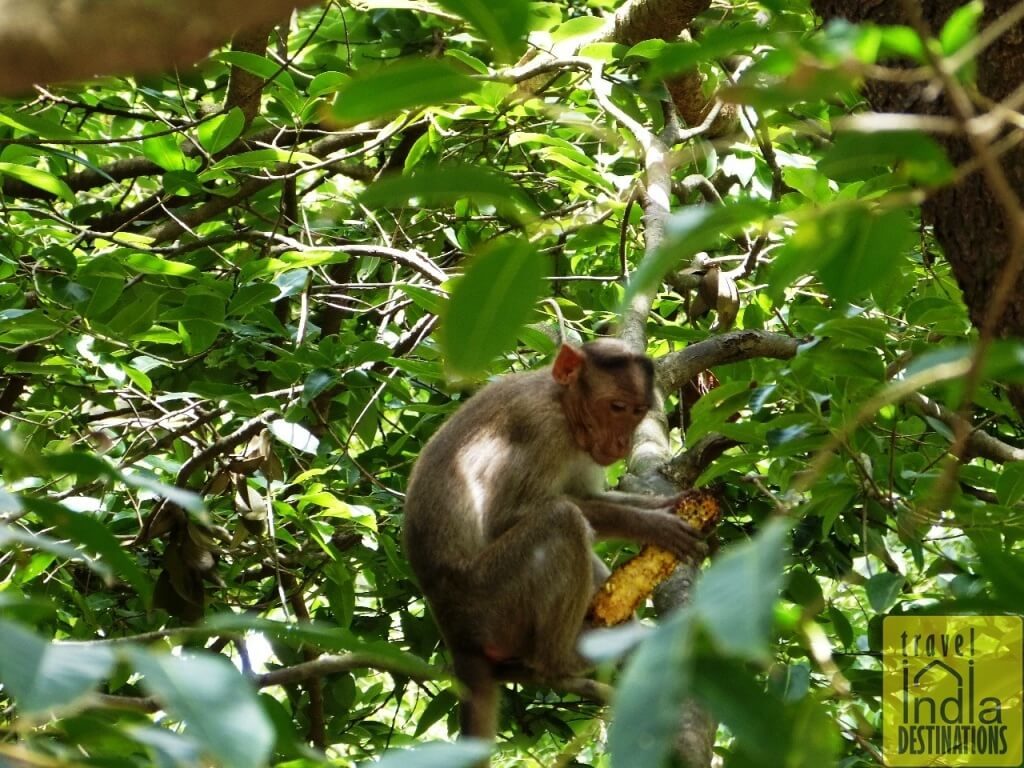
Monkey with a Grilled Corn on a Cob
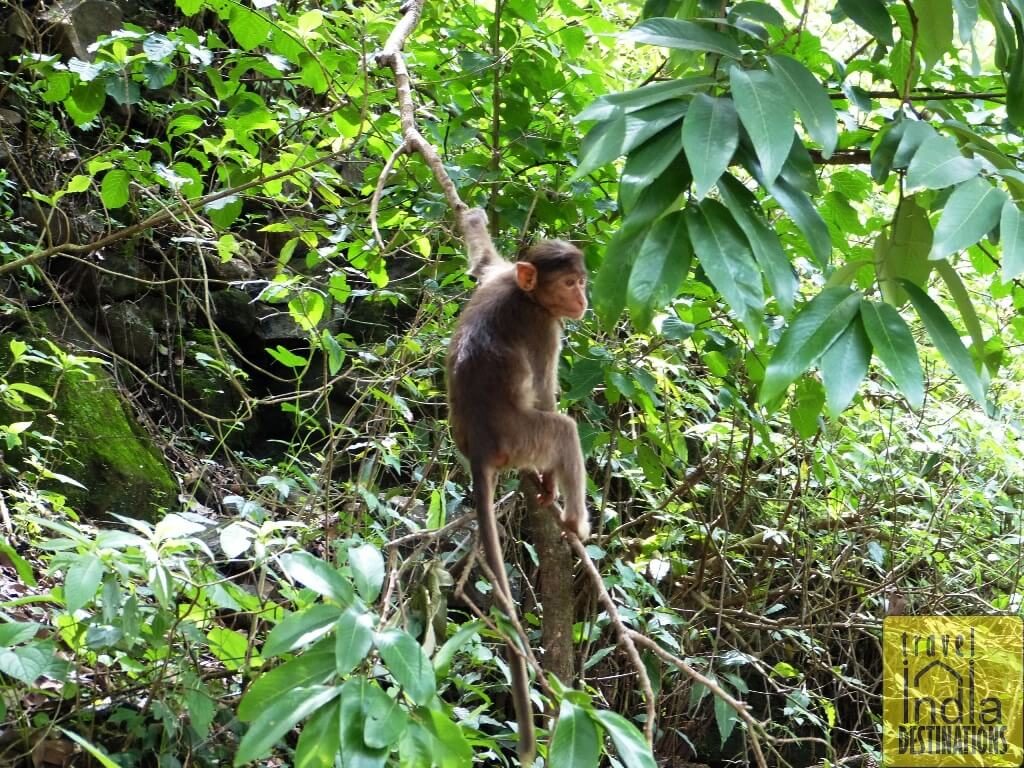
Waiting for the food donor
While the monkeys were busy looking for corn-donors around, infants were busy playing and jumping around in the bushes. I guess, kids are not really bothered about food, they just want to hang out with buddies alike. We moved on further with our Lohagad Fort trek.
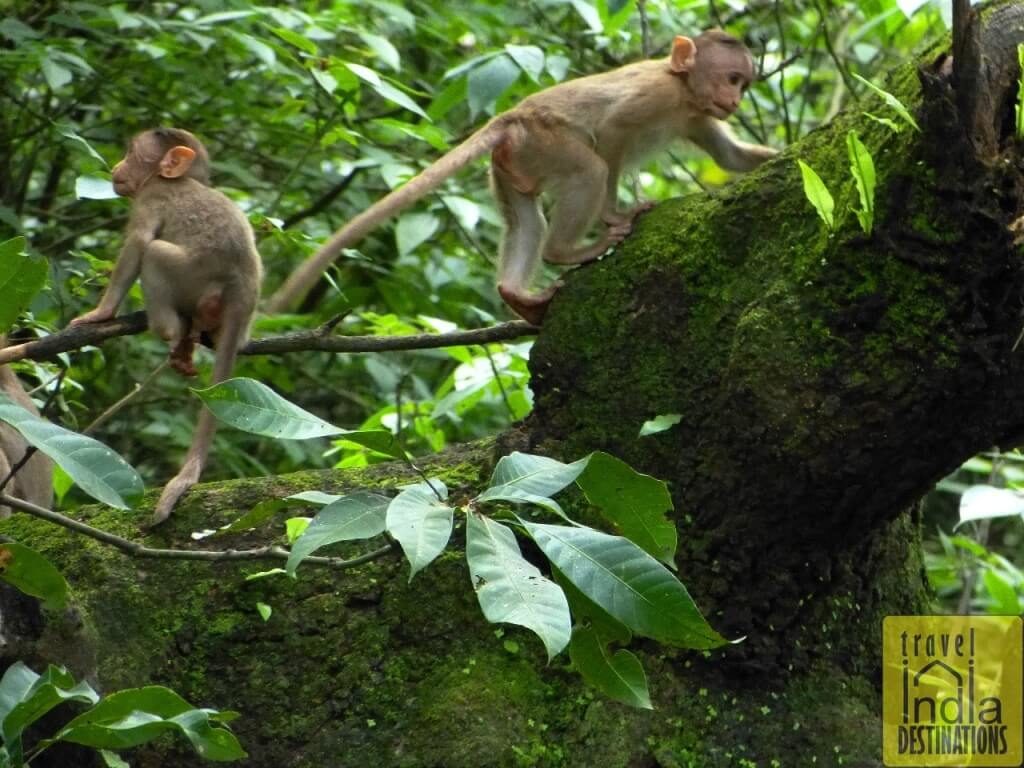
Infants Playing Around
As we hiked higher, we saw the road that we walked. The road ahead leads to the Pavna Lake. Some of the views were obstructed by the trees. However, there are certain places that offered a bird’s eye view of the location.
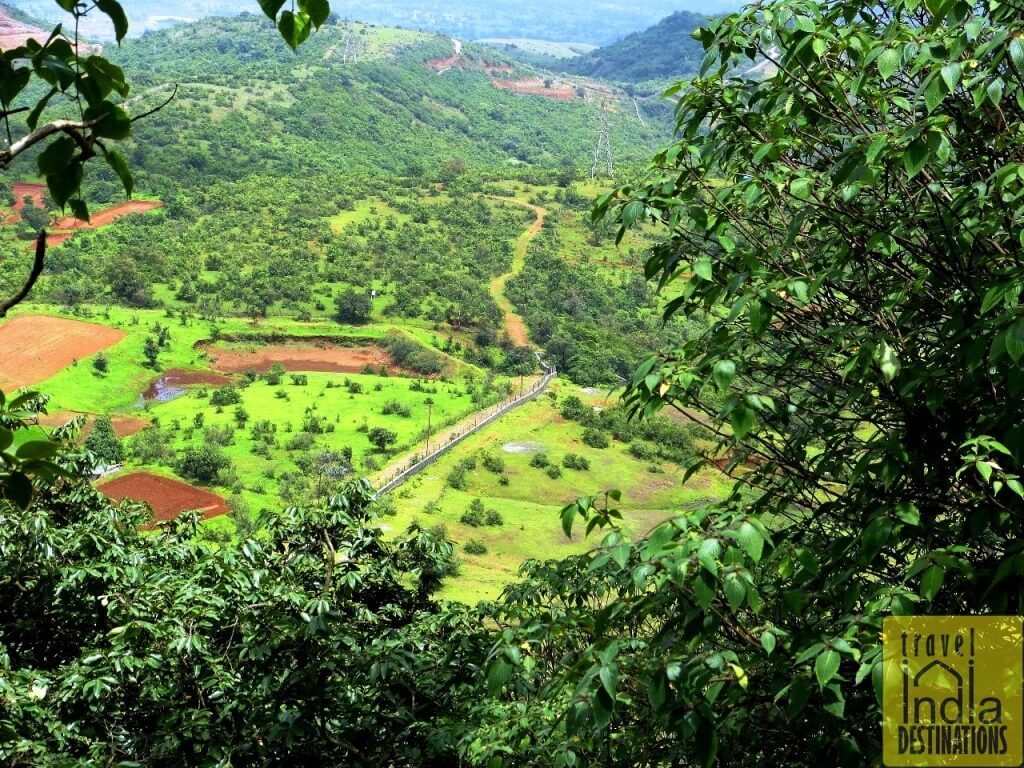
The Road Left Behind
We finally reach a spot from where we could see a wider view of the mountains all around us, but still, there’s a long way to climb up.
Tip: Always carry plenty of water. Wear a cap and sunglasses to avoid harsh sunlight. Also, wear full-sleeve clothes to avoid sunburn on a Lohagad Fort trek even during the monsoon season.
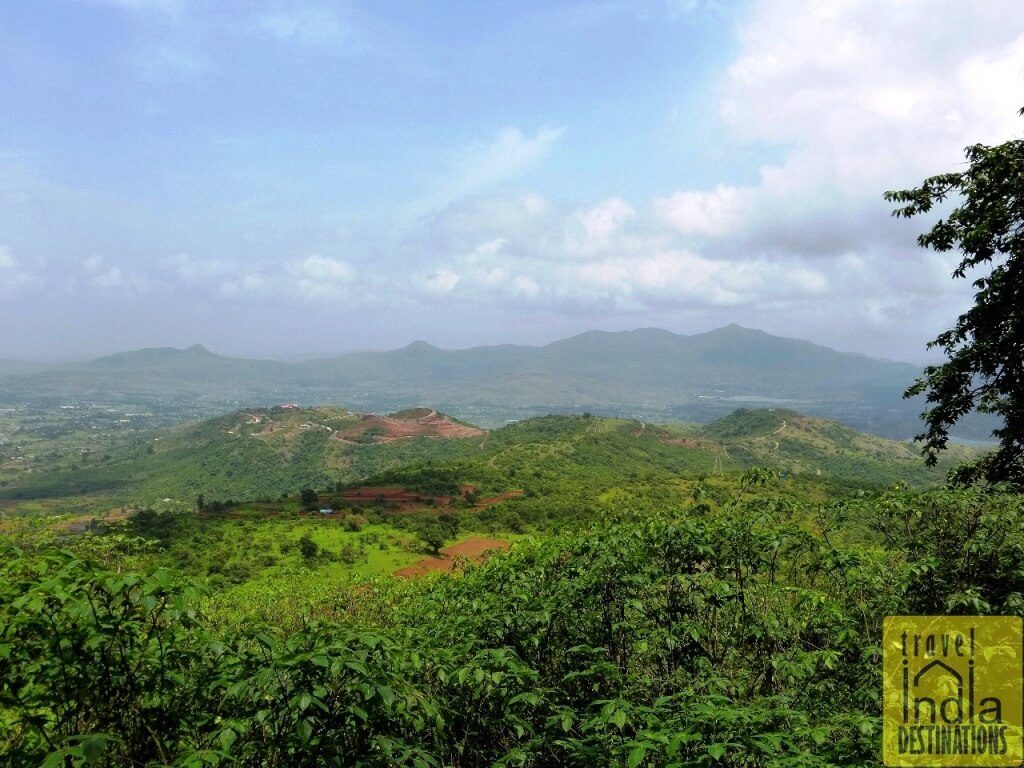
We Finally Get the First View
Ah! we finally get a first glimpse of the Pavna Lake which certainly is way too far from here, but from the top, it seems like its just a distance away.
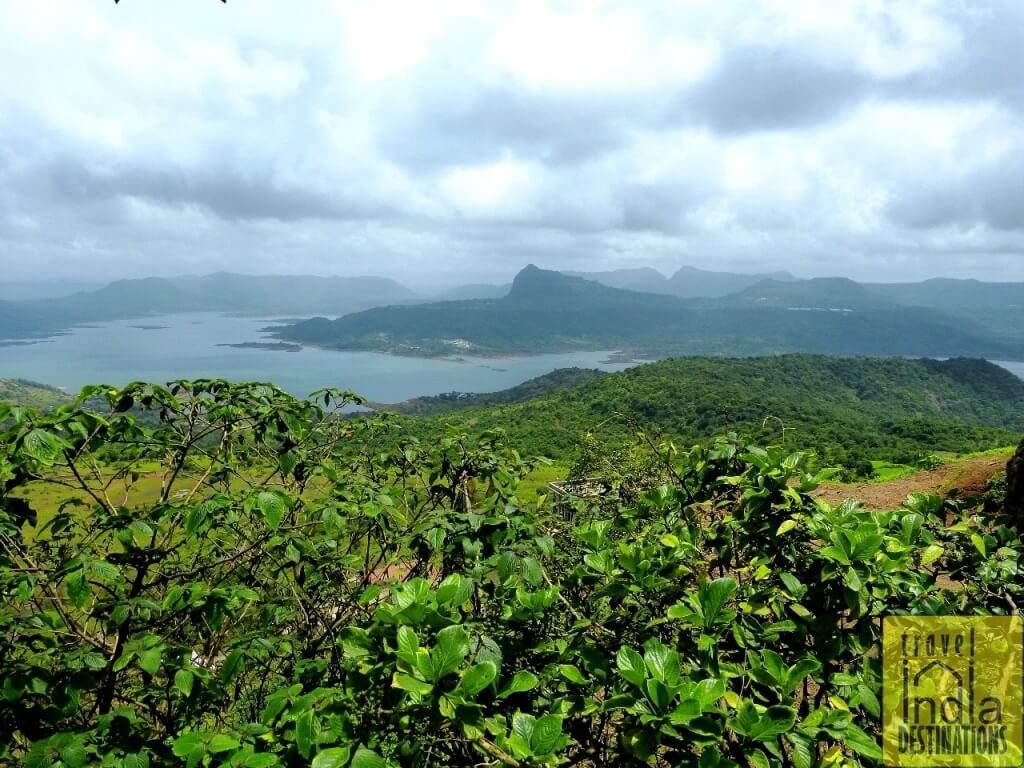
We Got a Bit Higher
If you’re staying in Lonavala longer you can also visit Pavna Dam and Lake. When the weather is good, you can enjoy some boat activities at the lake. Lonavala is one of the popular hill stations close to the city.
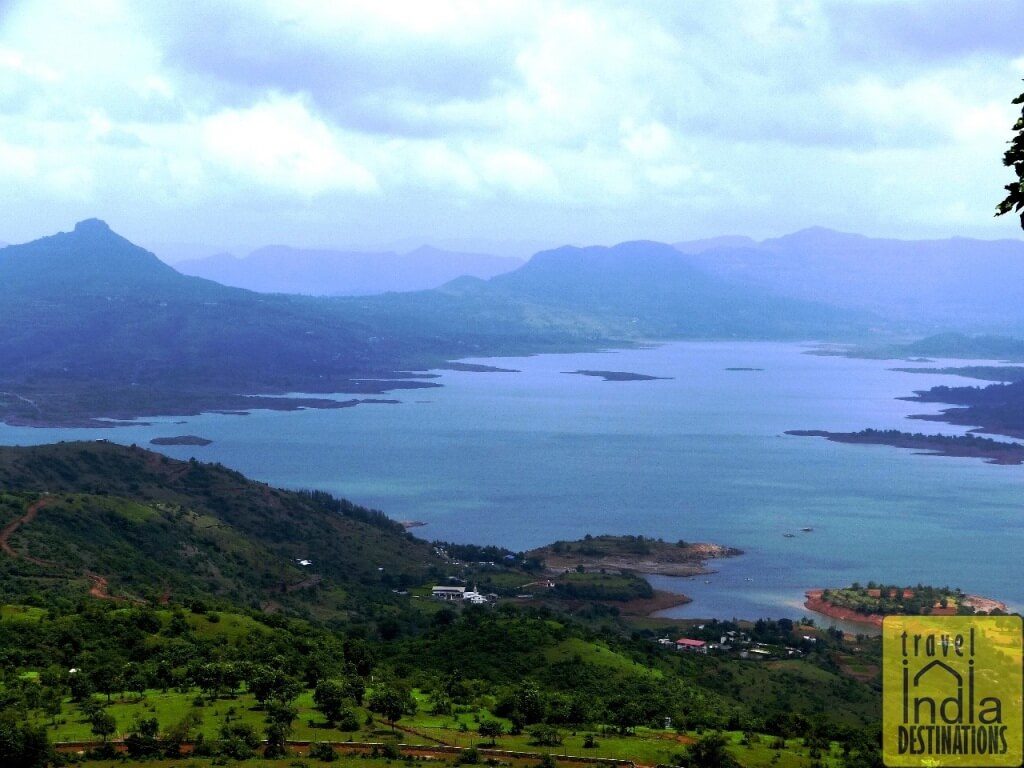
The Majestic Pavna Lake
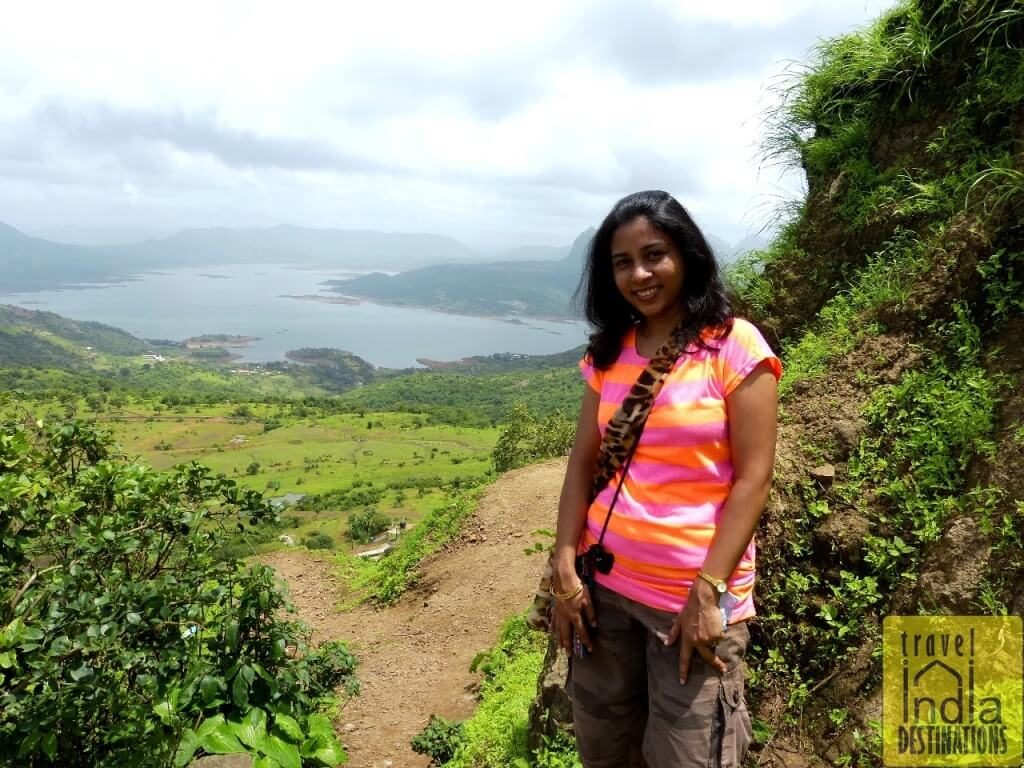
Sarah with Pavna Lake Backdrop
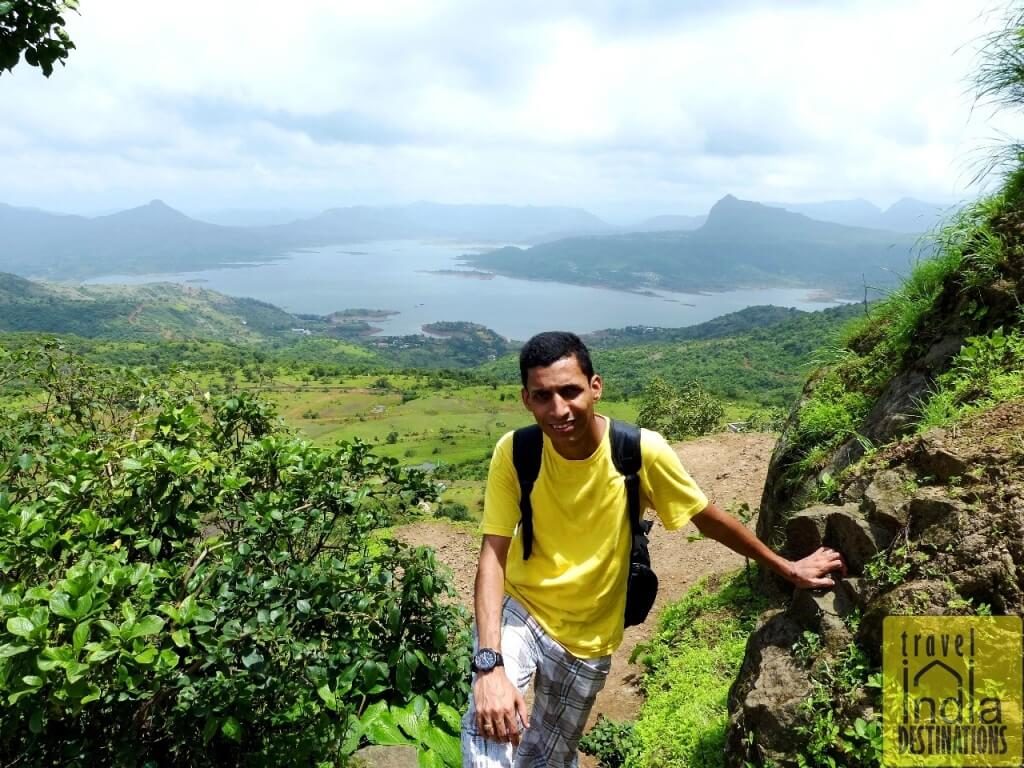
Me with Pavna Lake Landscape
We all decide to take a few seconds break to catch our breath, so we decide to take some pictures. Always be careful when you are taking pictures because you don’t want to slip accidentally.
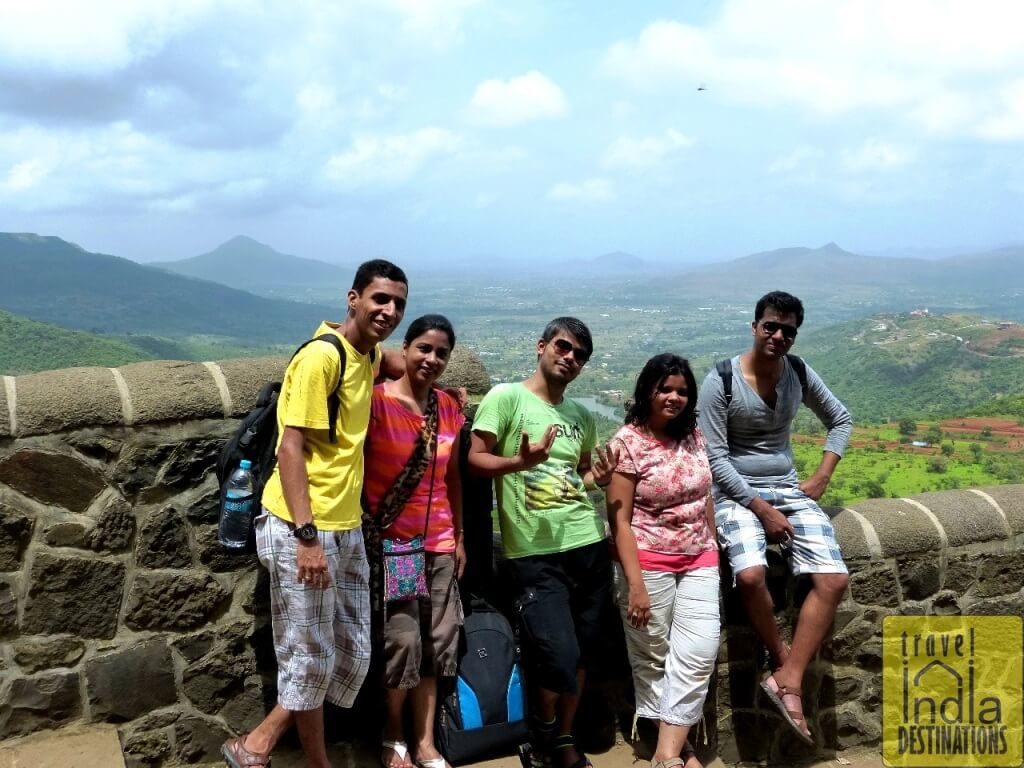
We All Take a Pose
After climbing up for around 40-45 minutes we see the first structure that looks like a fort. A feeling of triumph and satisfaction floods our heart as we begin to realize that our goal is not too far away. Our Lohagad Fort trek was going to be successful.
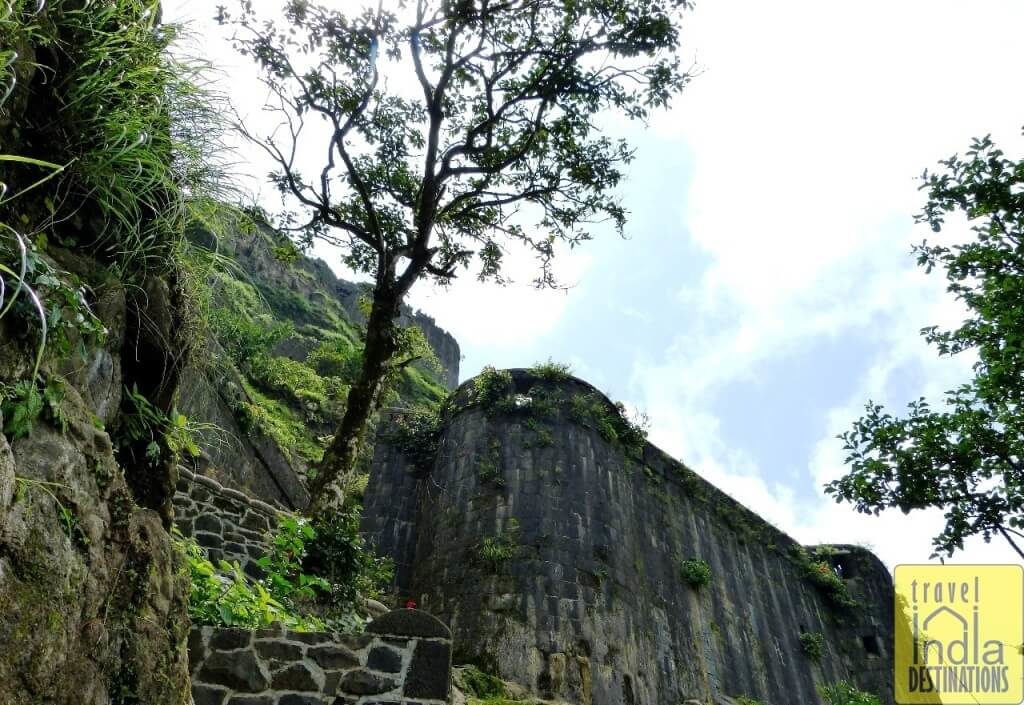
Bastion of the Fort
We finally reach the first gate of the fort which is also known as the ‘Ganesh Darwaza’ named after Lord Ganesh.
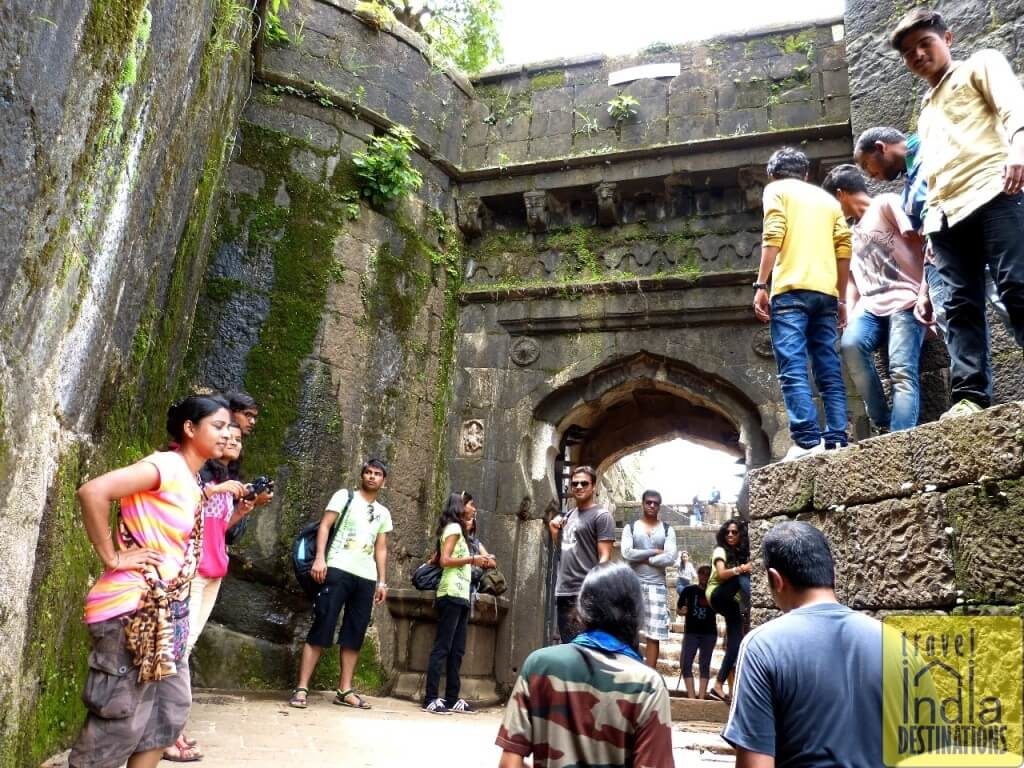
The First Gate of the Fort
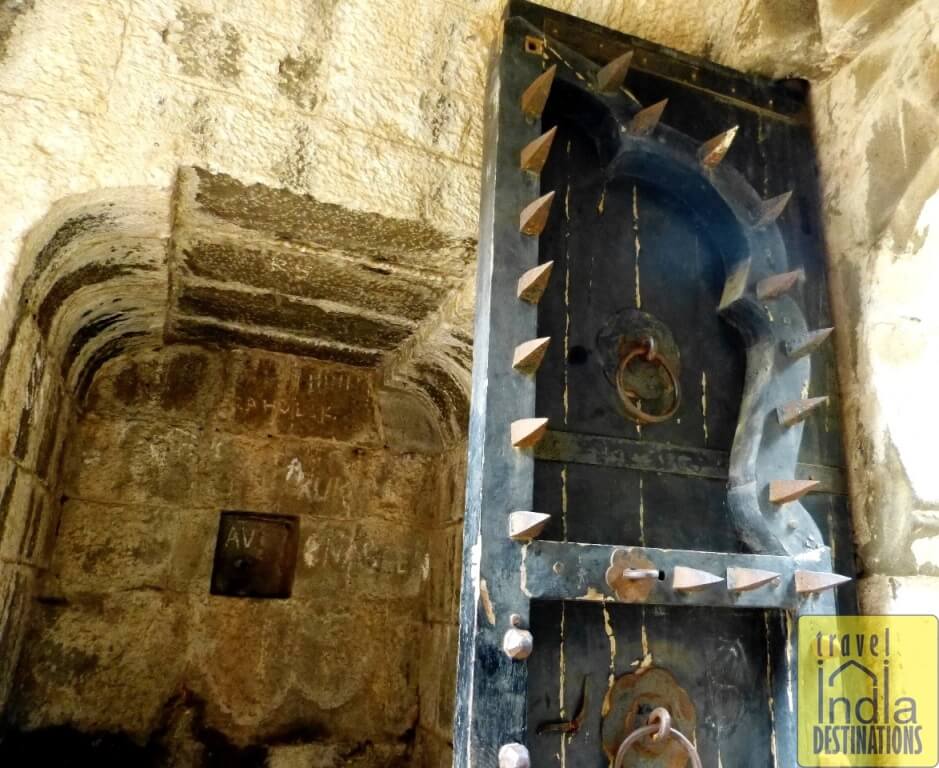
Fort Entrance Door with Iron Spikes
The First Gate had these iron spike door that was pretty much intact. Some spikes were missing, but it certainly is a heavy wood door and the rusted spikes are pretty much sharp enough.
The fort is built from the rocks from the mountain and historically it dates back around 2000 years ago. It was ruled by the Chalukyas first, then it fell into the hands of Rashtrakutas and then Yadavas ruled it for many decades.
It eventually passed hands from the Nizamshahi of Ahmednagar to Adilshahi of Bijapur. In 1648, Chhatrapati Shivaji Maharaj captured the fort and took it under the Maratha Empire.
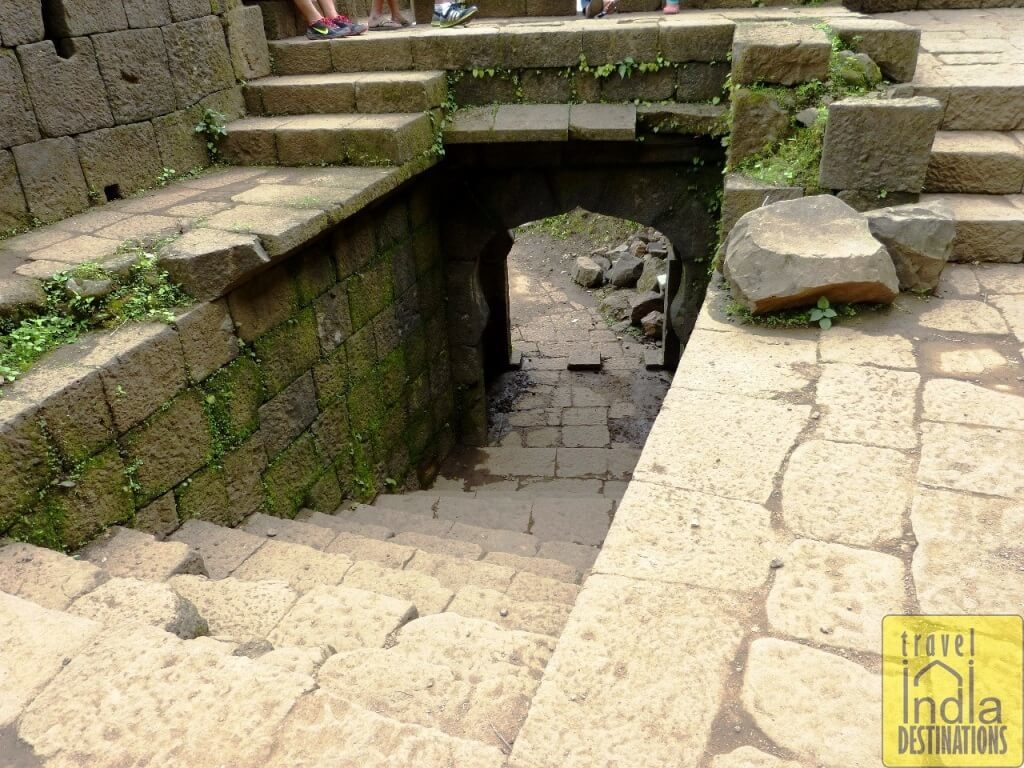
Another Entrance Way Inside the Fort
In 1665, Chhatrapati Shivaji had to surrender the fort to the Mughals under the Treaty of Purandar, but he recaptured the fort just five years later in 1670, and this fort was used for storing treasury. However, Mughals decided to get their hands on it once again and the fort once again went under Mughal power. This indicates the importance of this fort because of its strategic location.
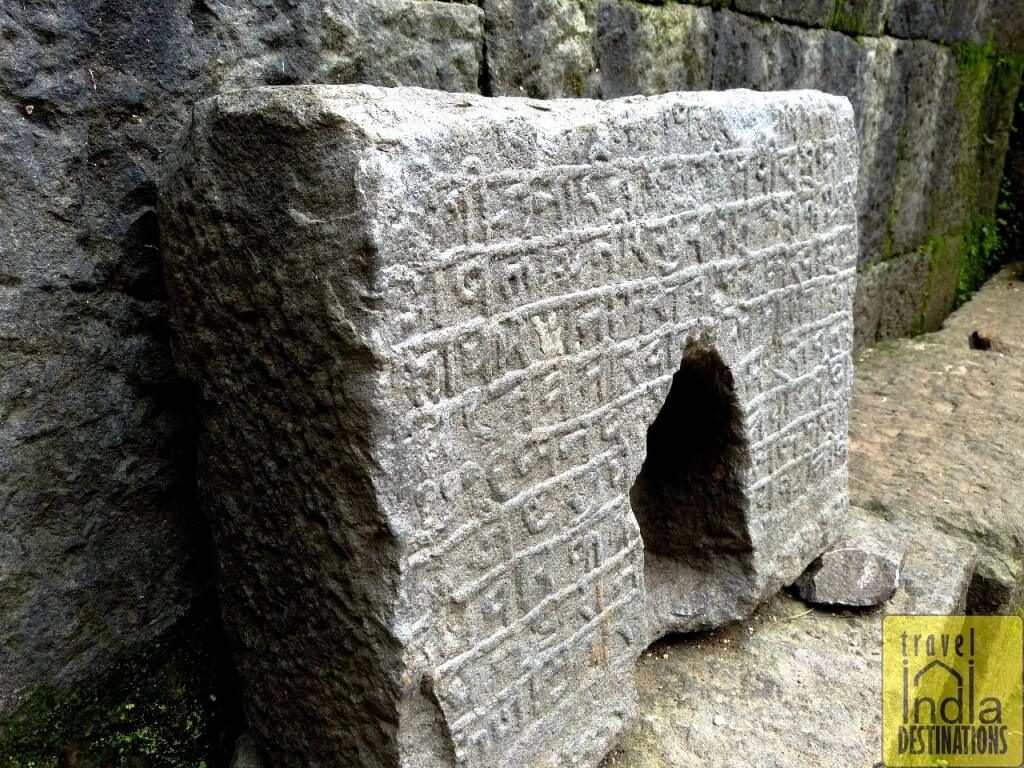
Scriptures Carved on the Stone
In 1713, Sarkhel Kanhoji Angre (Sarkhel means Admiral of the Naval Fleet) of the Maratha Empire, captured Lohagad Fort. He defeated the Mughals and took over the Lohagad fort along with nine other forts. Soon after he met, Peshwa Balaji Vishwanath who accepted Chhatrapati Shahu as his king. Sarkhel Kanhoji Angre decided to hand over the fort to Peshwa Balaji Vishwanath and the fort now came under the Throne of Satara.
Peshwa Balaji Vishwanath took great care of the fort and passed it down to Nana Phadnavis, who was then the Chief Minister of the Maratha Empire. Nana Phadnavis realized the importance of the fort to store treasury which was crucial to the functioning of the Empire and got the fort renovated.
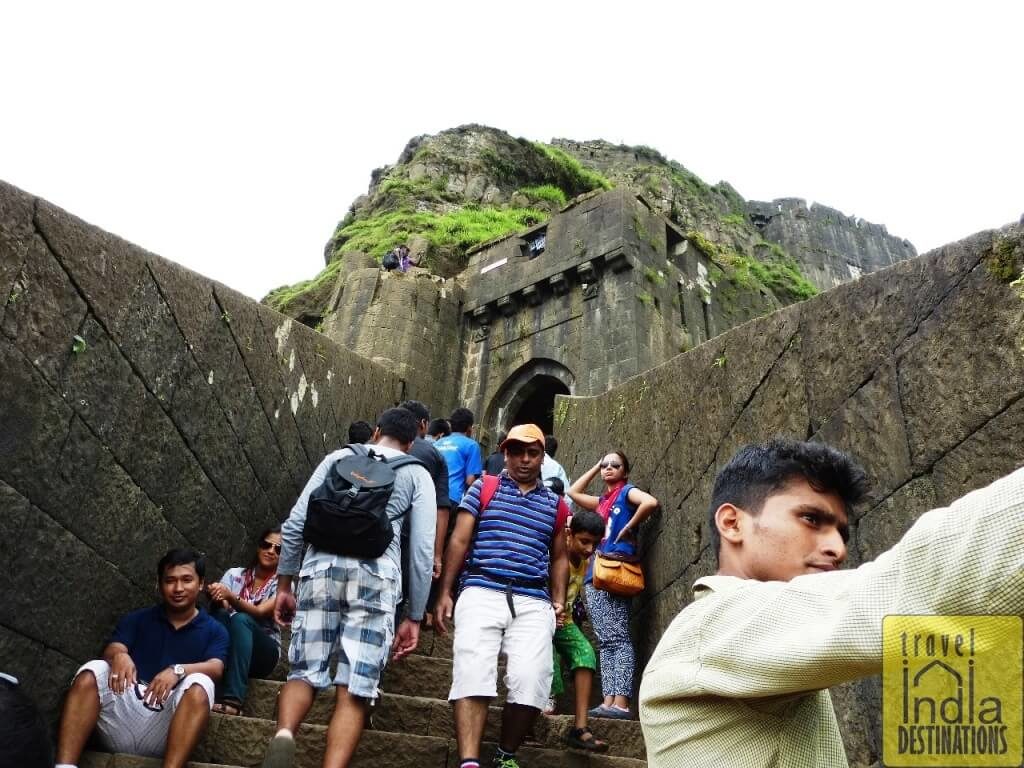
Climbing up the Narayan Darwaza
In the picture above, we are climbing up the steps of the second gate called ‘Narayan Darwaza’ which was not a part of the earlier fort structure. In 1790, Nana Phadnavis, Chief Minister of the Maratha Empire and the supervisor of the fort, came up with a new plan to create a way for easy access to food supplies.
The gate construction took 4 years and it was ready by 1794. Many people who come on Lohagad Fort trek take selfies and pictures here.
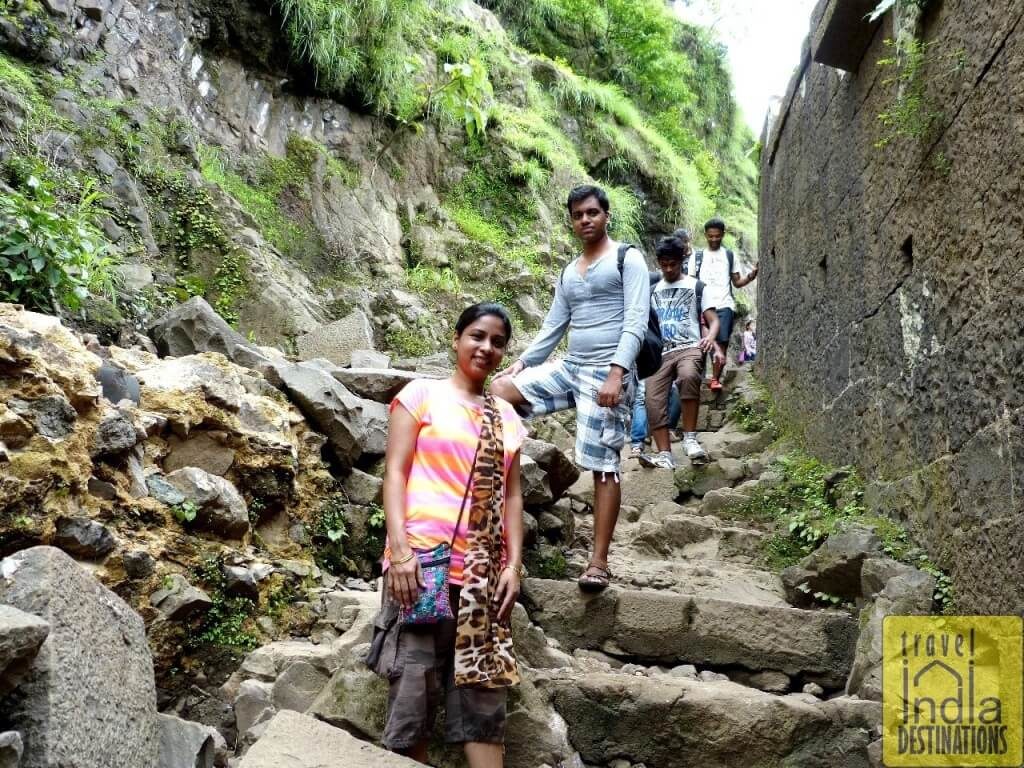
The Climb Gets Tougher
As soon as we crossed the second gate, (refer pic above) the smoothly carved stone steps turned into a rocky climb. The steps are weathered by the rain and heat and therefore hikers have to be more careful. At some places, the passage gets narrow, so hikers climbing up and down have to adjust accordingly. This is a tricky part of the Lohagad Fort trek so be patient and discipline here.
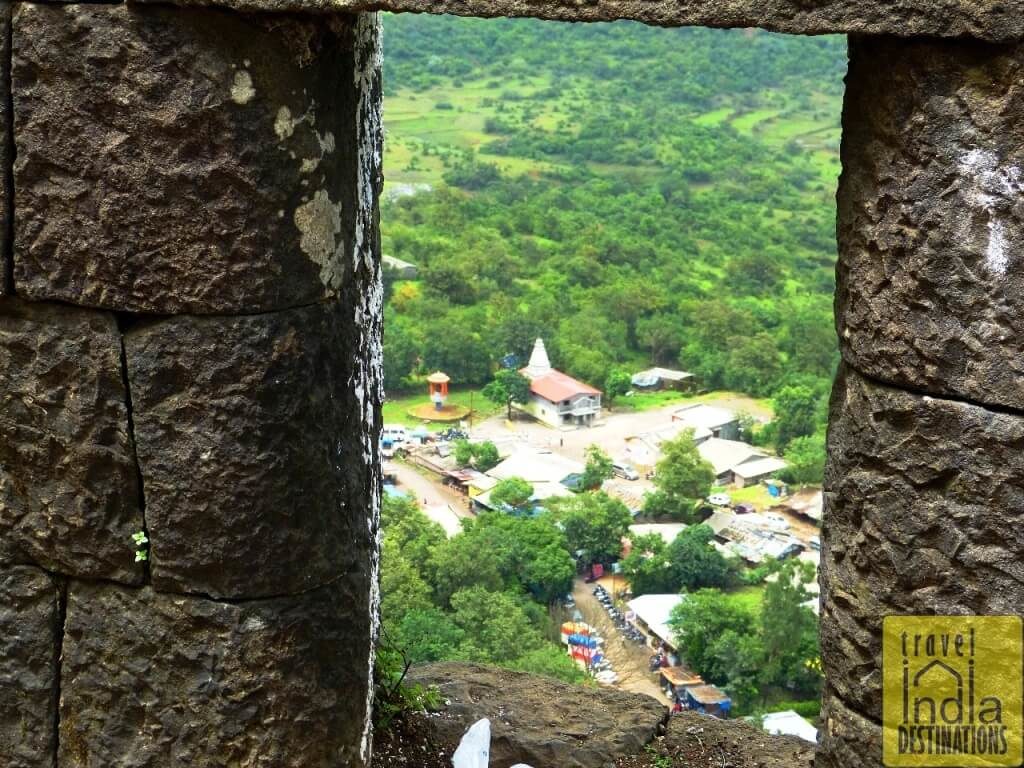
A View from Fort’s Window
From above, we can see the way below. In the picture above, you can see the settlement at the foot of the mountain and some refreshment stalls and restaurants that cater to the tourists. You will see the picture of these stalls below in the post.
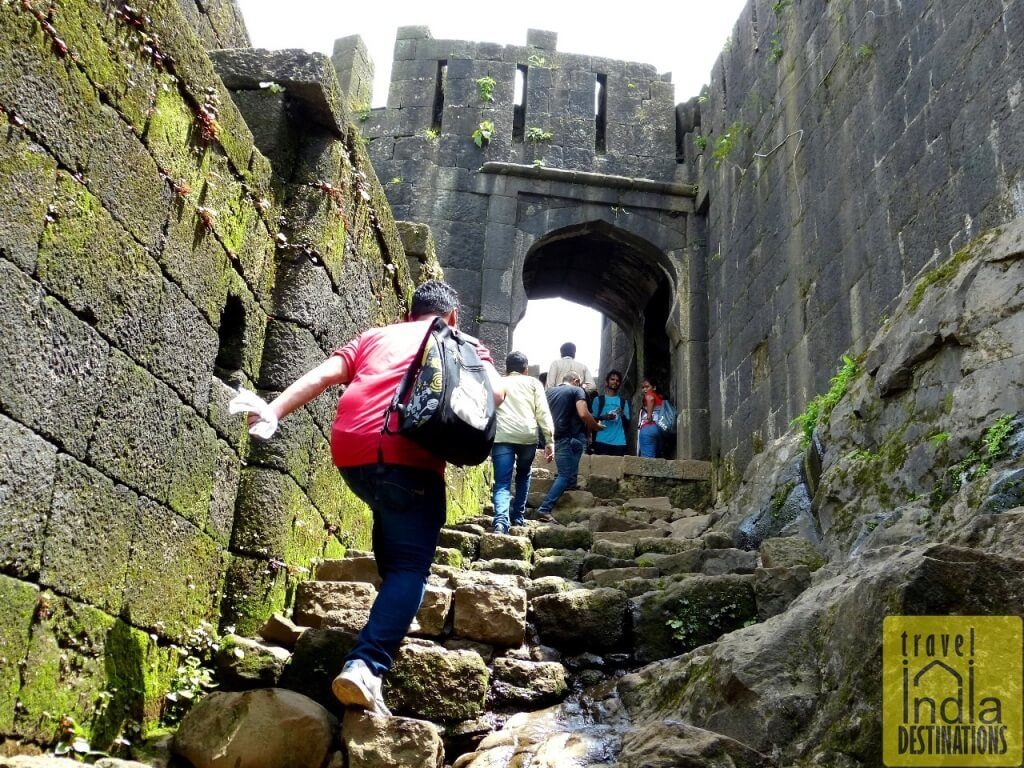
Slippery Wet Rock Steps Ahead
As we moved higher and inched towards the end of our Lohagad Fort trek, we were facing another challenge. The steps were abrupt and wobbly and now the rocks were soaked with rainwater. The water was dripping from the gaps in between the stones, probably leaking from the lakes and wells on the top of the fort. The moss-layered stone steps were slippery and we had to make sure we look for dry spaces where we can step on to move ahead.
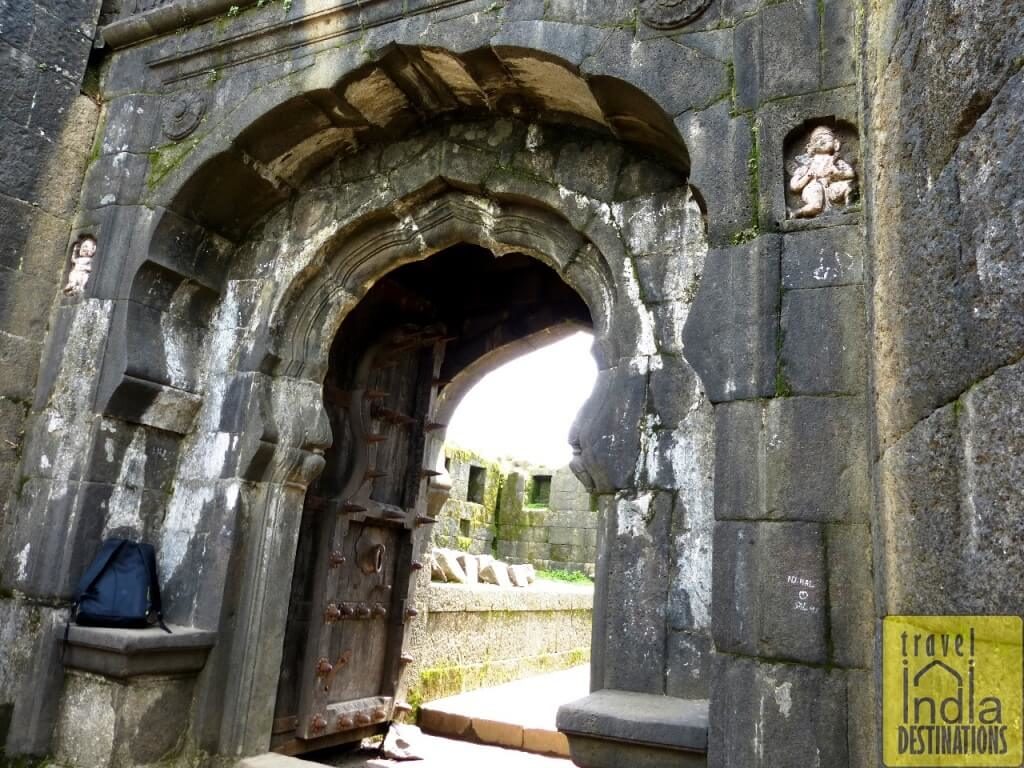
The Third and Final Gate
We finally reached the final and third gate of the fort called the ‘Hanuman Darwaza’ named after Lord Hanuman. In the picture, you can see the carving of Lord Hanuman on both sides of the gate. It is said that the gate was re-made by Nana Phadnavis when he took control and supervised the fort. The door has iron spikes and knockers on it.
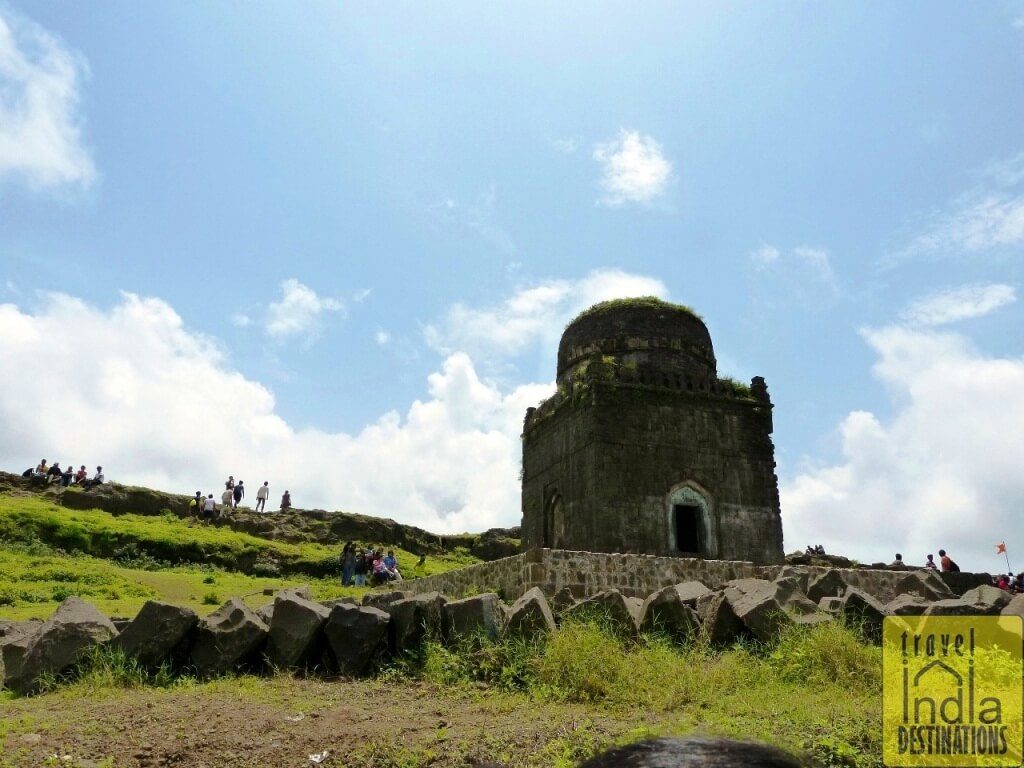
The Moment You Walk Inside the Final Gate
The moment you walk inside the Hanuman Darwaza, this is what you see. The fort is just a plateau on top. There are many broken and ruined structures that are now covered by wild plants. The only structure that still remains is the tomb. When British (East India Company) captured the fort, they razed most of the structures of the fort to the ground. Thereafter, the fort was rendered inactive.
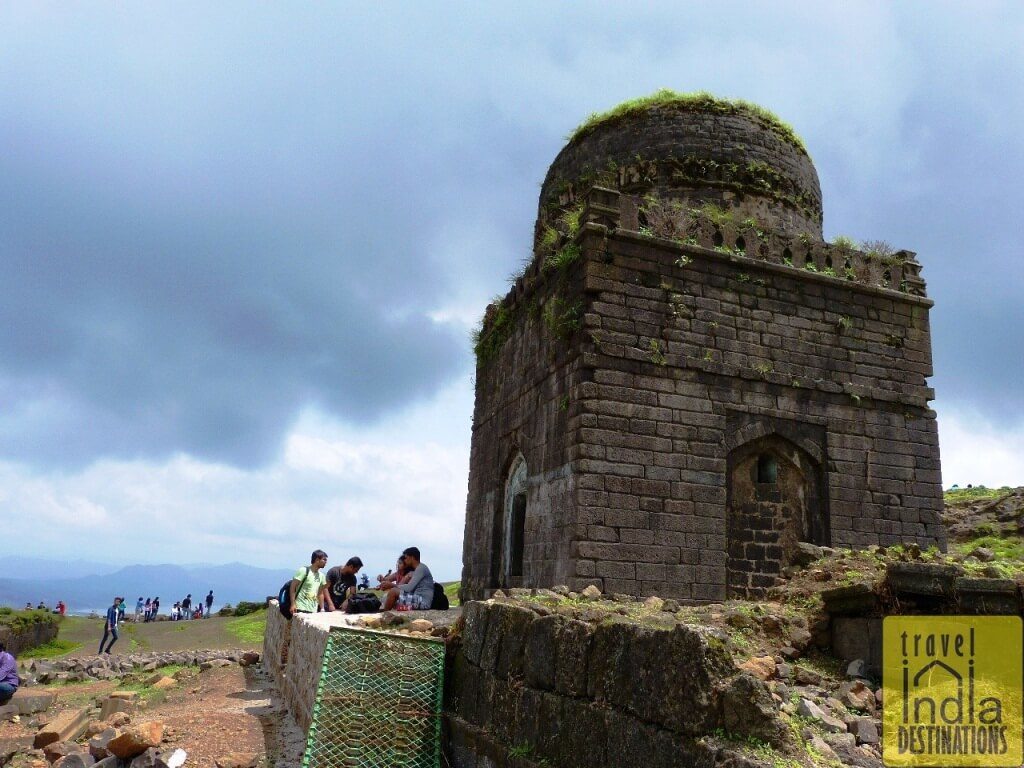
We Take a Halt at the Tomb
No one really knows much about the tomb. While some claim that it has a body of an Arab invader Shaikh Umar, some claim that it holds the body of Aurangzeb’s daughter. It is said that the body was buried here when the fort was under the Mughal Empire. There are two more unknown tombs towards the east of this structure.
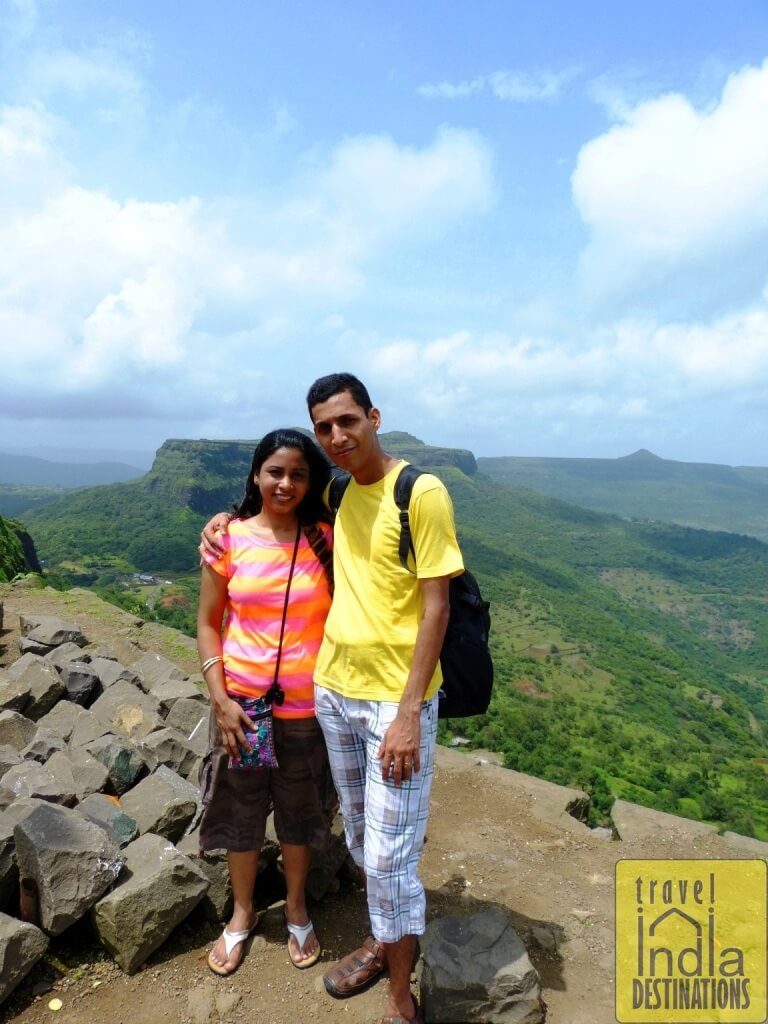
Me and Sarah and Visapur Fort Behind Us
I and Sarah take time to pose. You can see the mountain rocks around us and behind us is the north-east view. In the background, you can see the Visapur Fort.
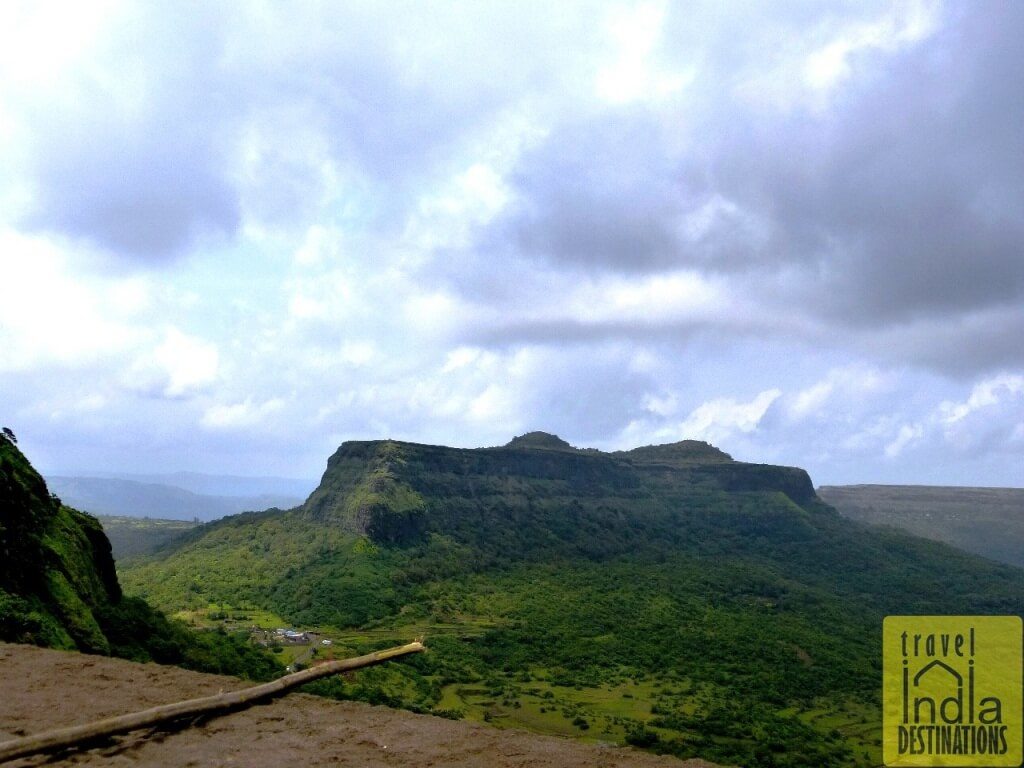
A view of Visapur Fort from Lohagad Fort
Okay, just in case you weren’t able to see the Visapur Fort because of us standing in between, here’s the full view in the above picture. In the picture below, I go to the edge of the fort to give you a full view of the hikers still behind us hiking up slowly on those wet rocky steps and the settlement at the foot of the mountain.
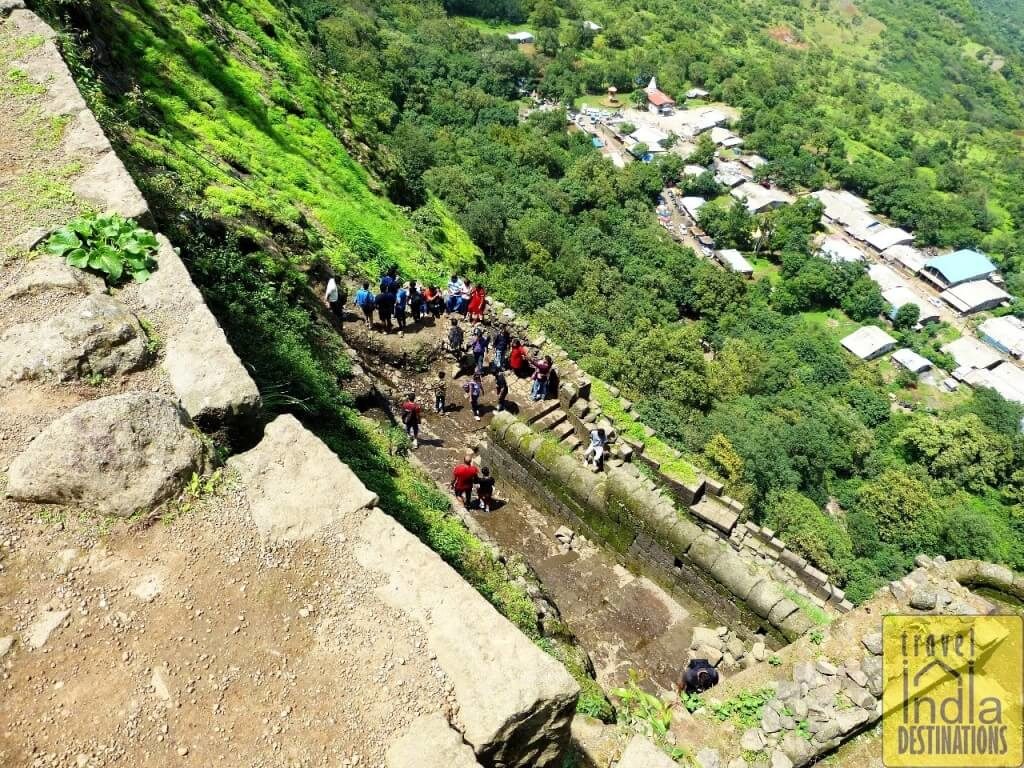
Hikers Hiking Up the Wet Stone Steps
No air conditioner in the world can match the freshness of the natural wind blowing right into the face. After all the climbing, I wanted the cool breeze to freshen me up and that is what I got here. I wanna fly like a bird.
Tip: When you are clicking pictures at the top of the Lohagad Fort make sure you don’t stand right on the edge. It is risky.
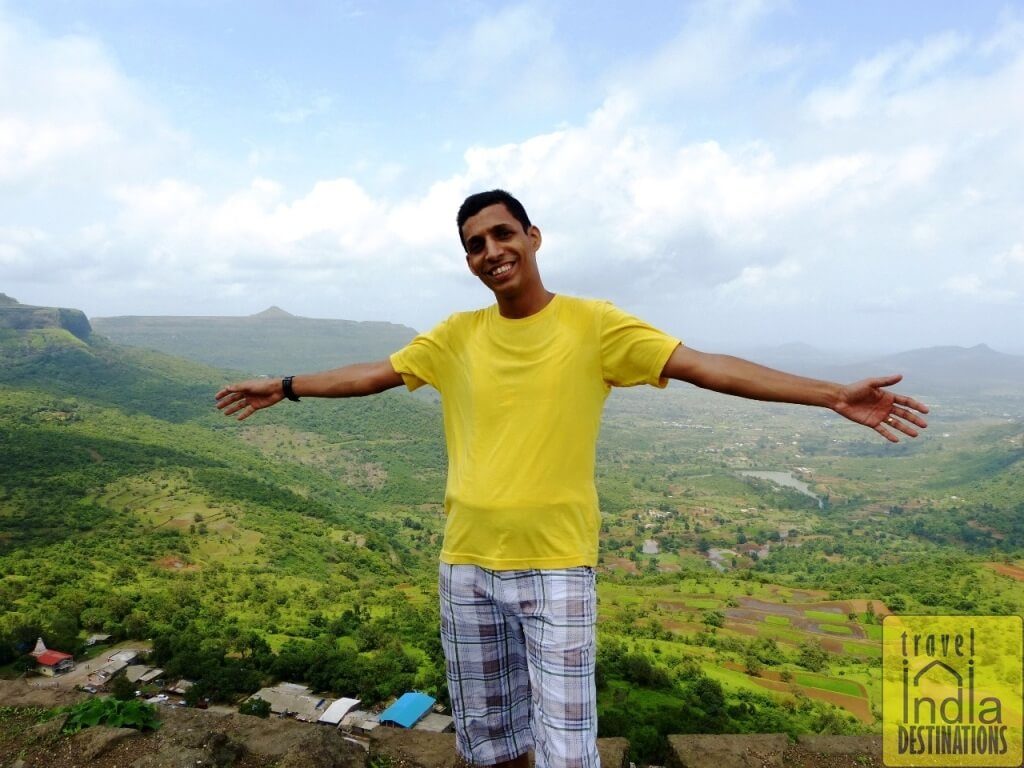
I feel like a bird flying in the air.
Sarah takes a halt on a stone which is a broken part of the fort wall with the Pavna Lake landscape behind her.
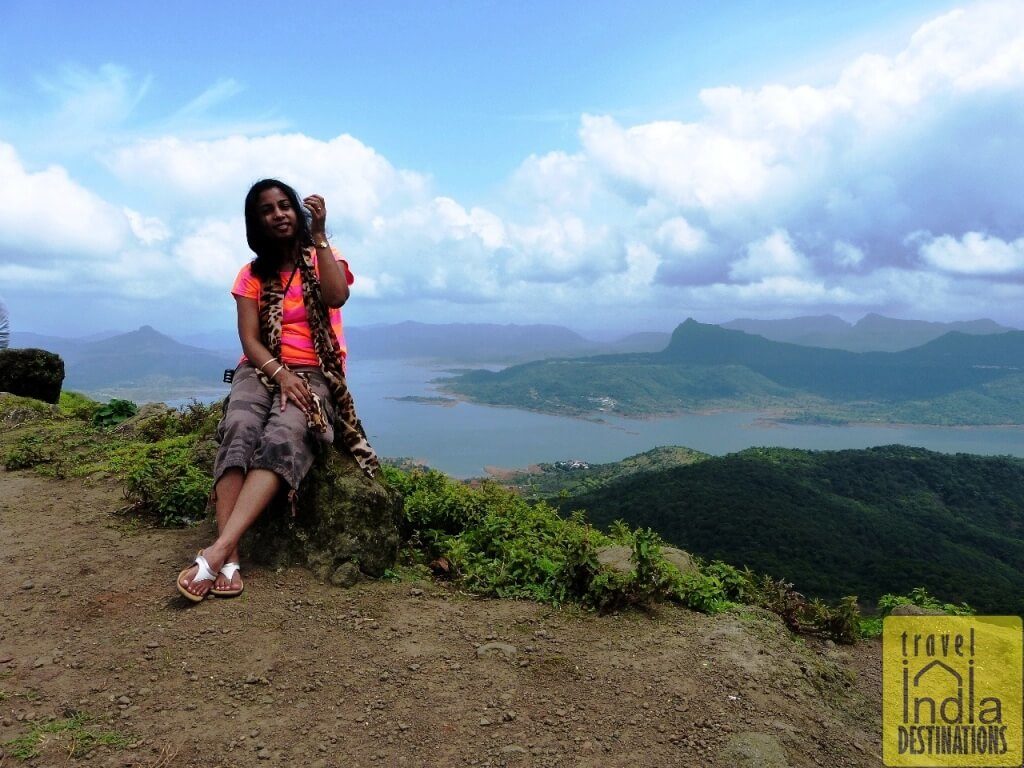
Sarah with the Pavna Lake view
Below is the view of the South-west side of the fort. The Gurumai Ashram is clearly visible in the picture below.
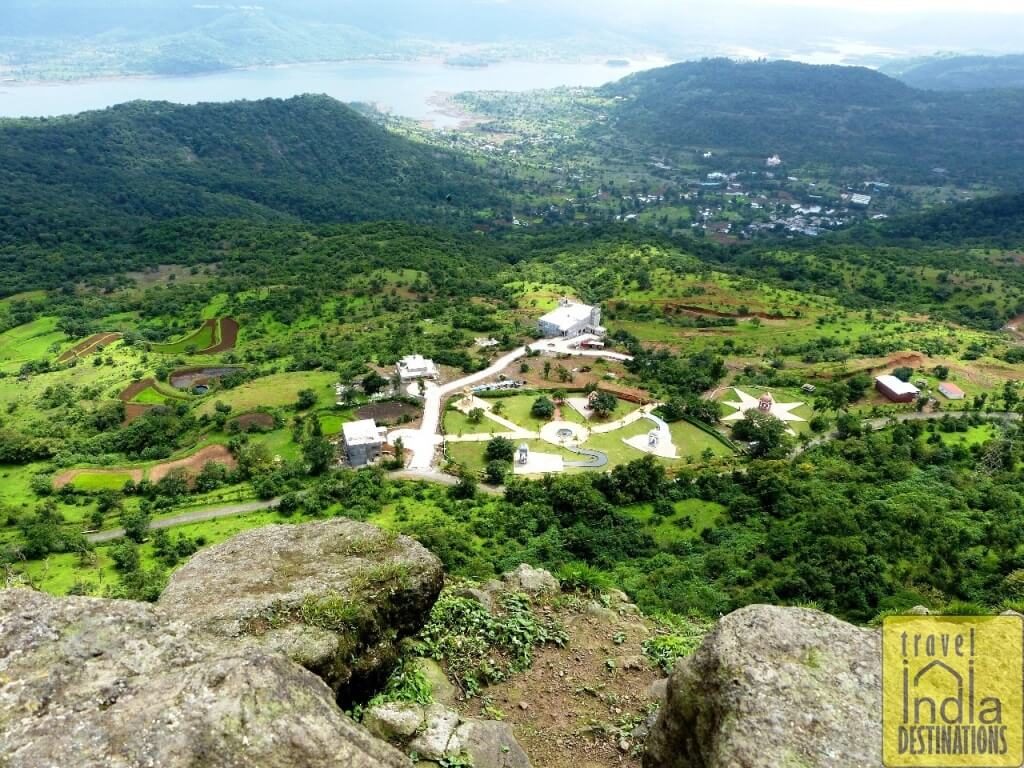
A nice view of the village at the foot of the mountain.
After hours of hike and intense heat, its time for some relaxation and cool water. My colleagues decided to enjoy the cool lake water and wet their feet before they move ahead.
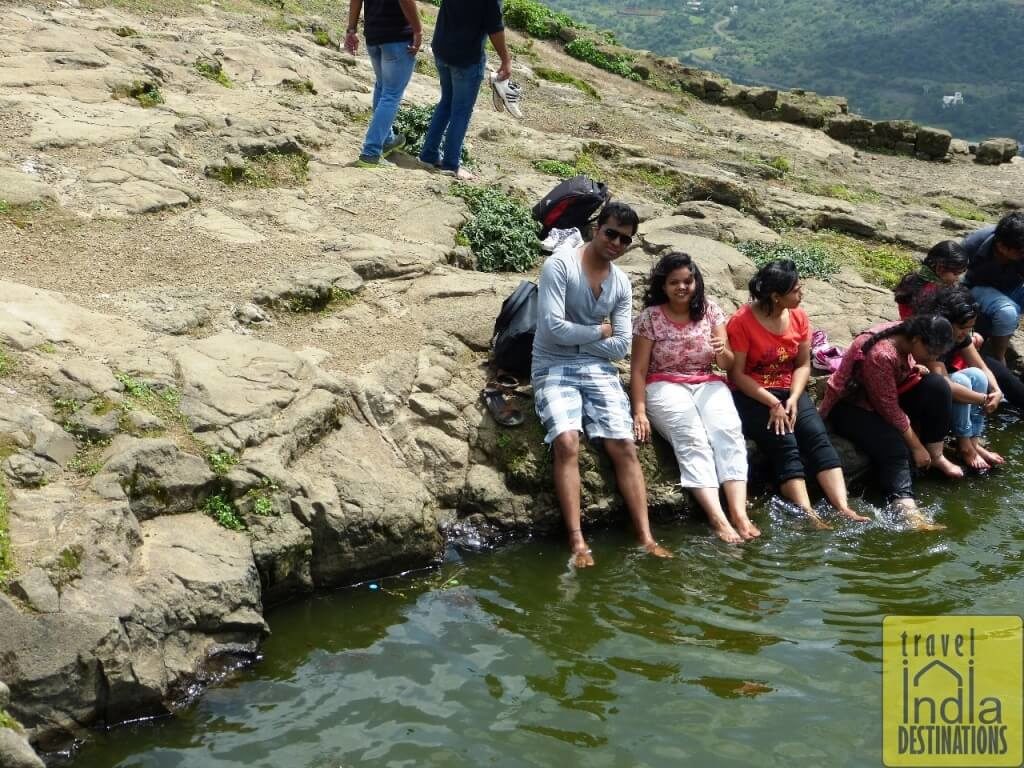
A good way to beat the heat.
These water tanks are the only source of water for the army and people living on the fort then. Now, it has become a temporary swimming pool for the hikers that dive in for fun and adventure.
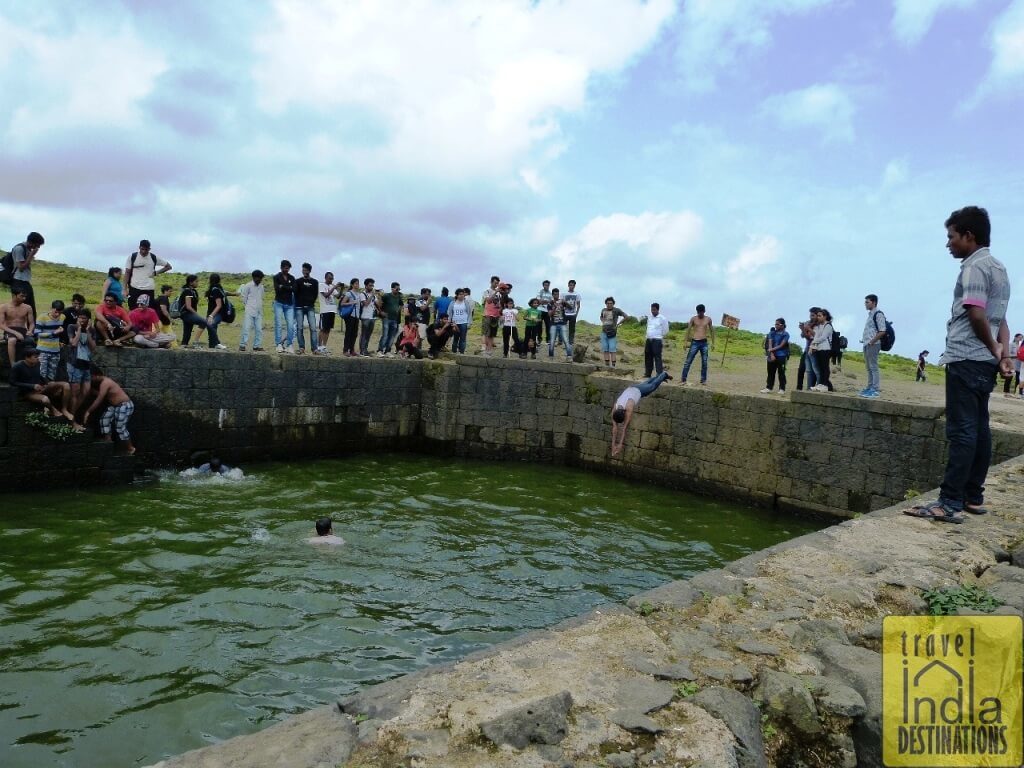
Tourists enjoying some water activities here.
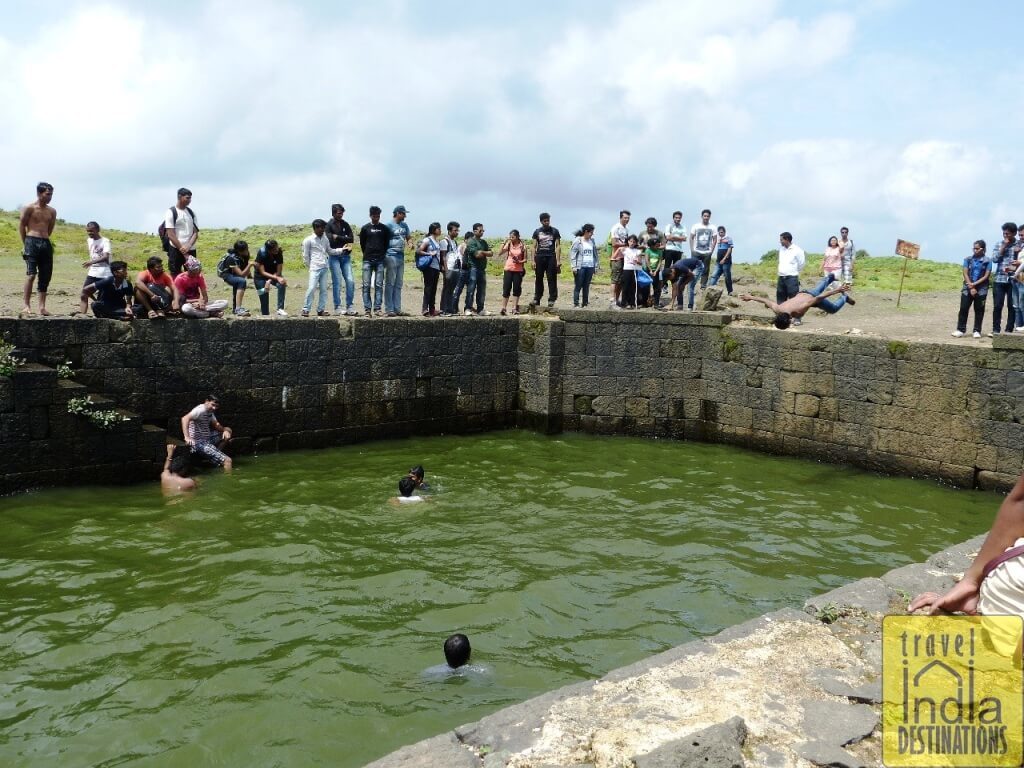
Tourists enjoying the bath
Splashing InThis giant well (in the picture below) which probably is deep was left alone. Not sure, but there are rumours that tourists have lost their lives diving into the well. Who knows what’s inside at the bottom of it?
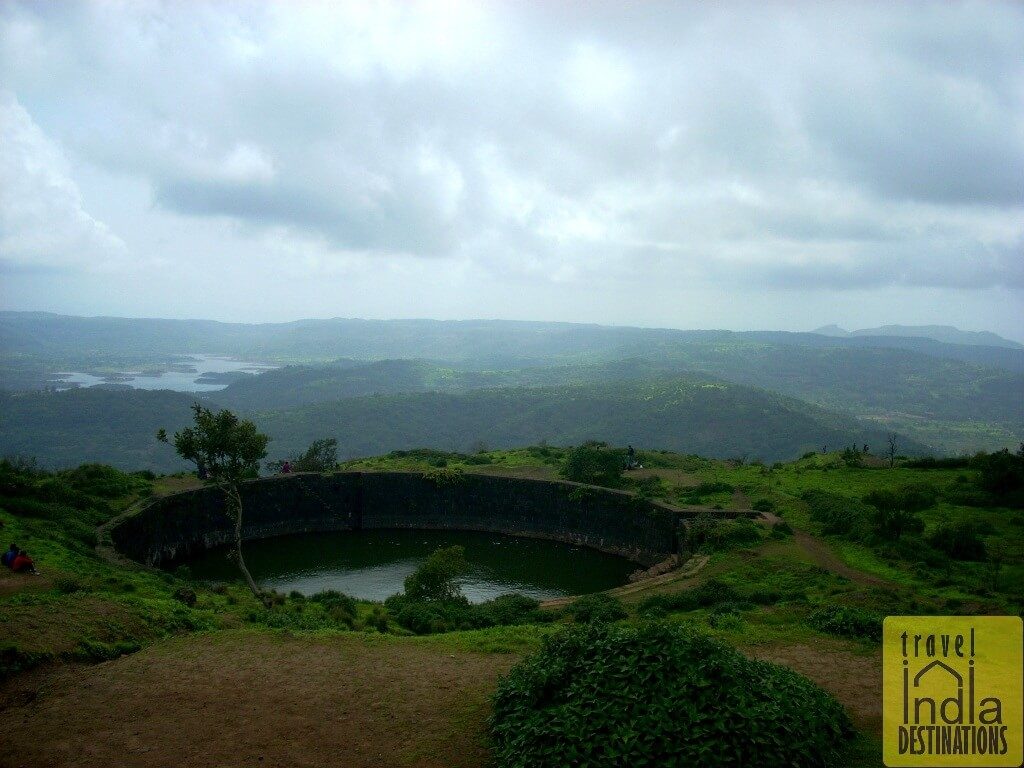
A huge well that is left untouched for reasons unknown
Here below is another temporary lake that you can see. On the east side of the fort, there are two unknown tombs.
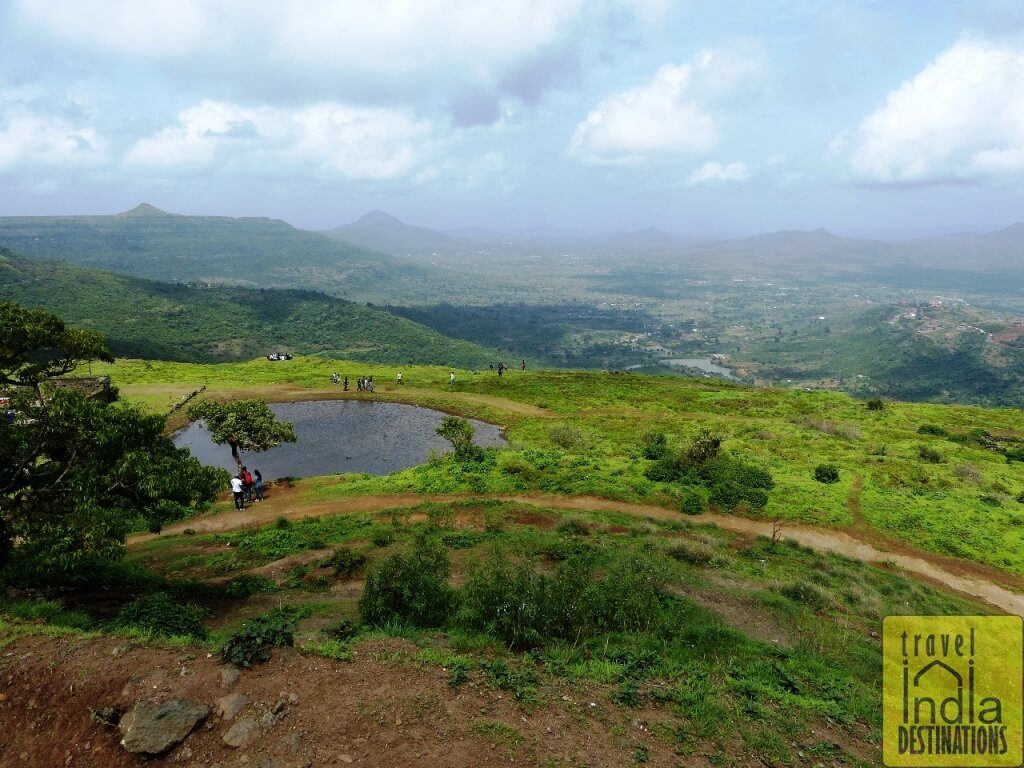
A Lake at the Top of Lohagad Fort
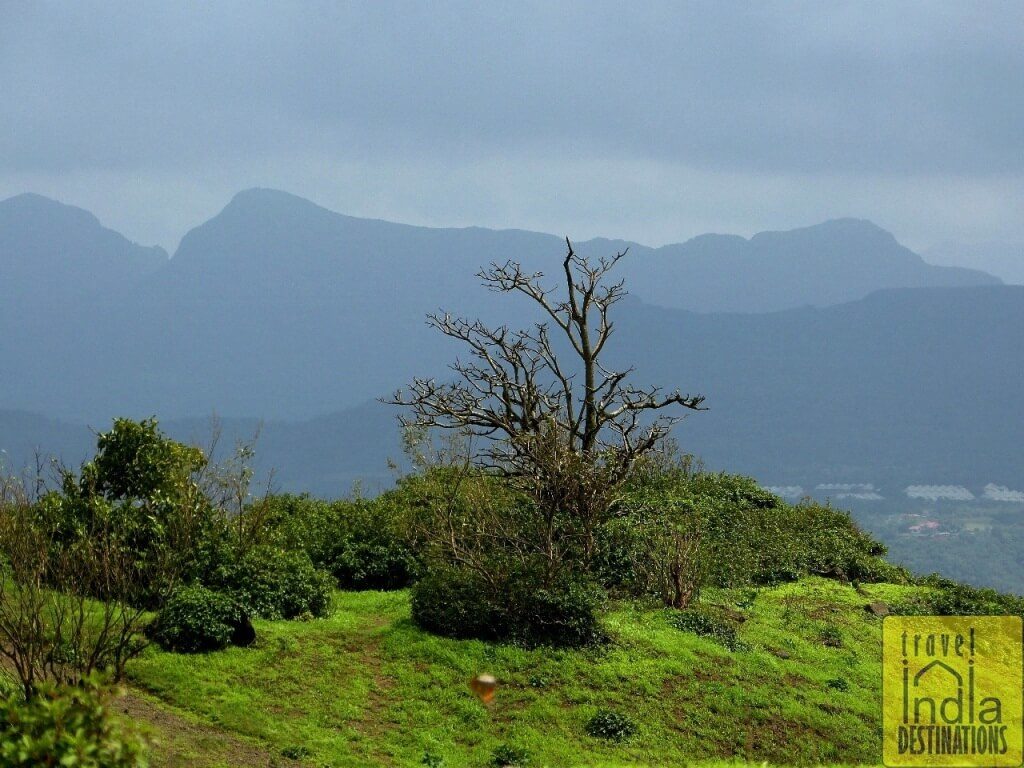
The dark clouds cover the mountains in their shade.
The picture above shows the south-east view from the fort. I decided to zoom in and take some shots of the mountains that were far away but under the shadow of the clouds.
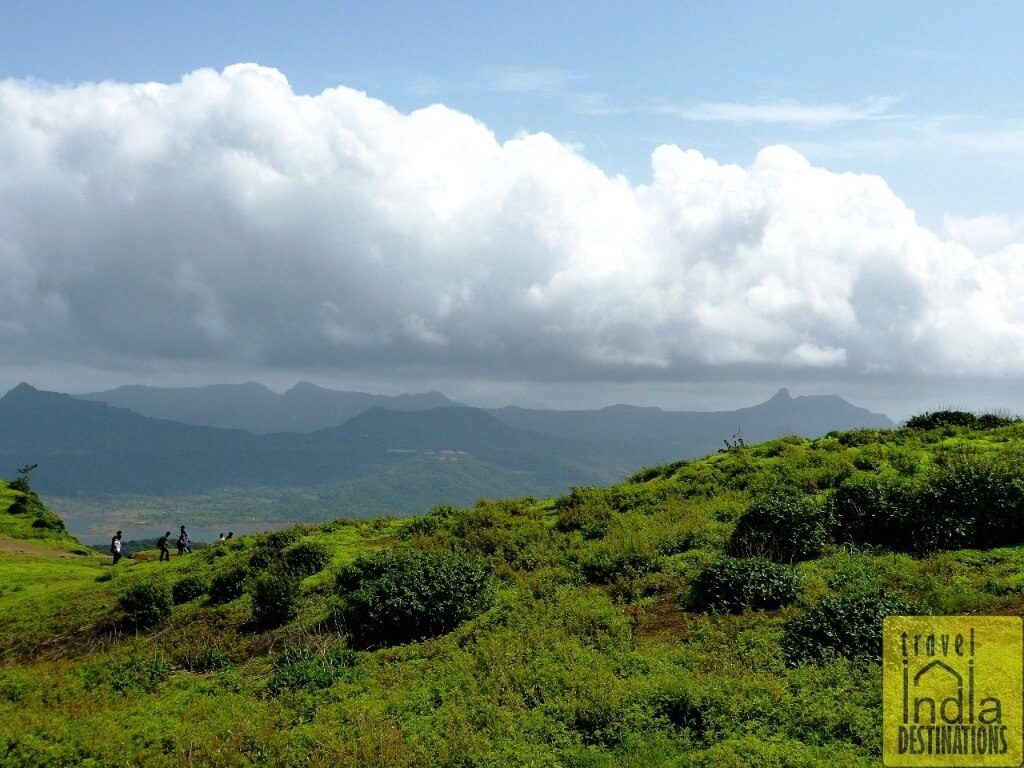
A place where clouds and mountains meet.
Towards the south side of the fort, you can see many mountain ranges in the distance. You can also explore the forts on these mountains. Lohagad Fort trek is also ideal for photographers and nature lovers.
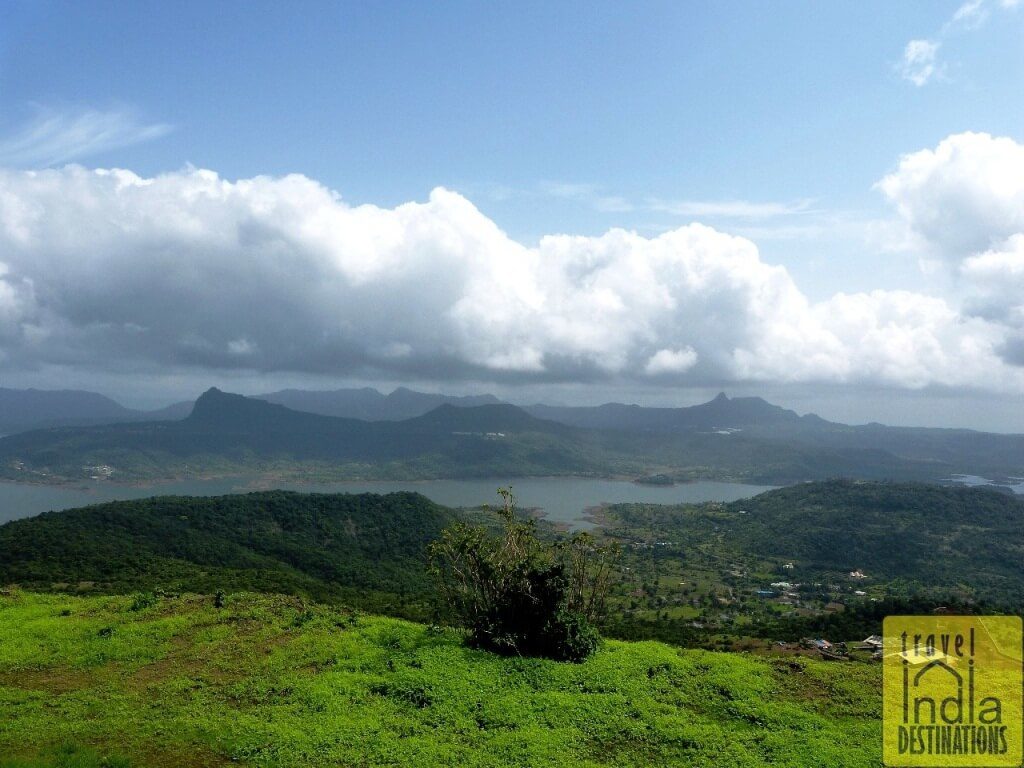
A good view of the Pavna Lake
Another landscape view with the Pavna Lake and the mountains and the white fluffy clouds hovering above.
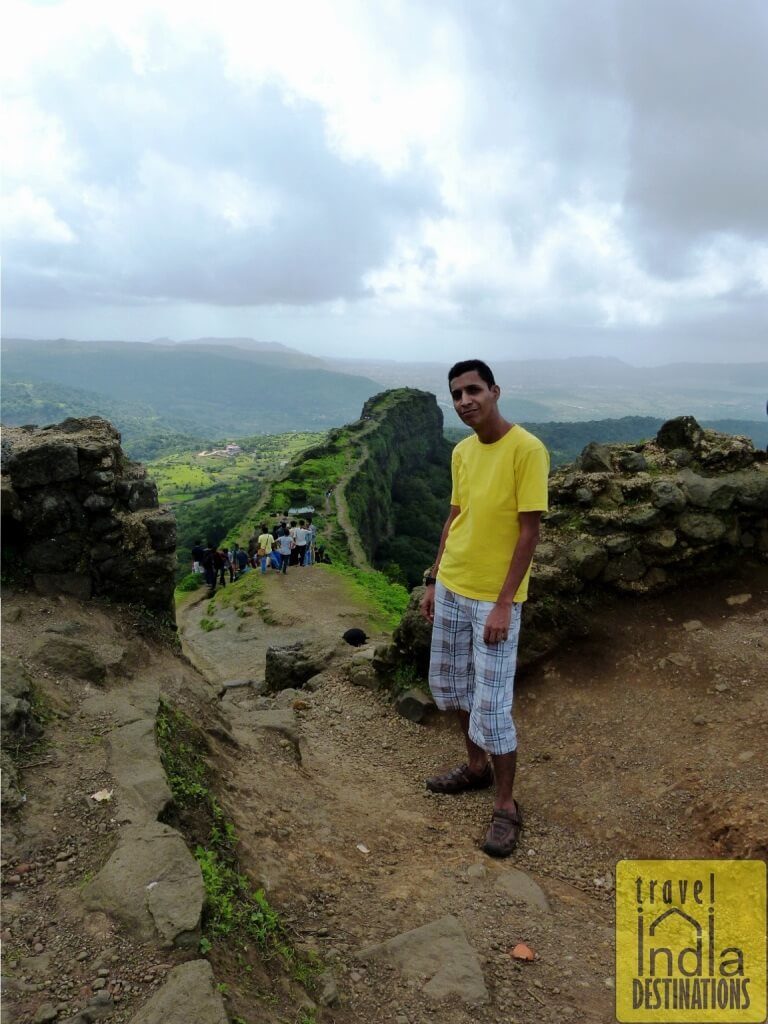
Behind Me – The Scorpion Tail
We decided to walk up the north side of the fort plateau until we reached the watchtower. I am standing at the watch tower which is the extreme north end of the fort. However, behind me is a space from where you can climb down around 10 rock steps down and reach where those people are standing.
You walk ahead 1500 meters in the north-west direction along the fortified spur called Vinchu-Kata which literally means The Scorpion Tail. The fort has a scorpion-like shape when seen from above. This is the best part of the Lohagad Fort trek.
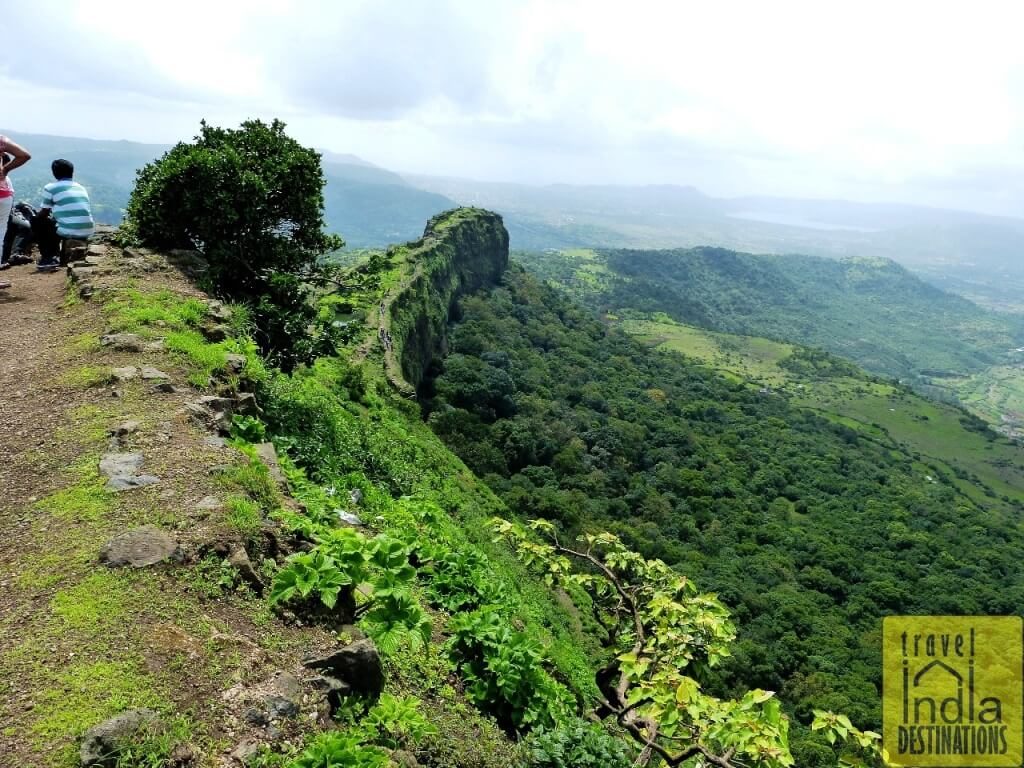
From Fort’s Watch Tower – The Scorpion Tail
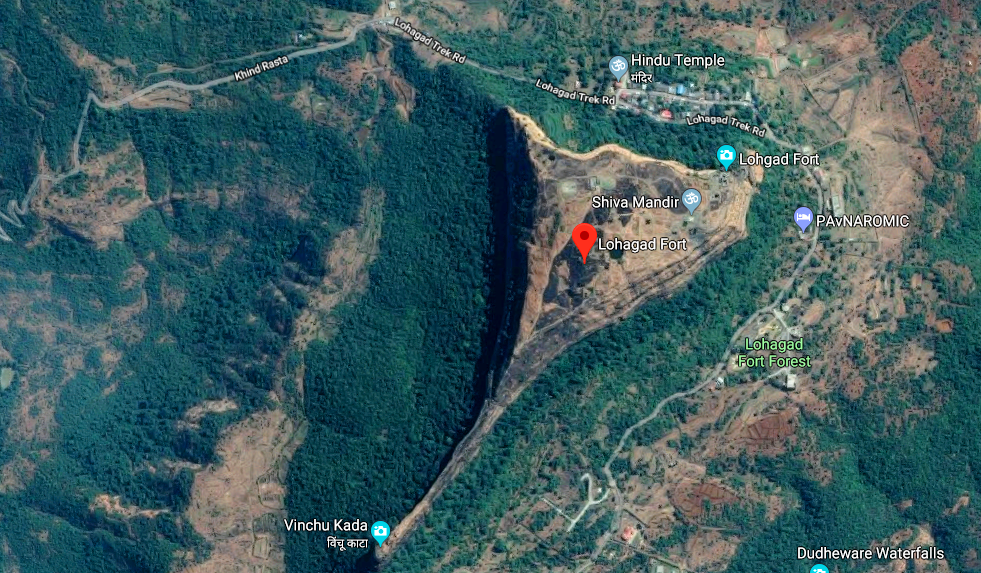
The Scorpion-like shape of the Lohagad Fort
The Scorpion Tail section of the fort is just 30 meters wide and has a very steep slope on both sides. During the rainy season, it is advisable to be extremely cautious while walking it.
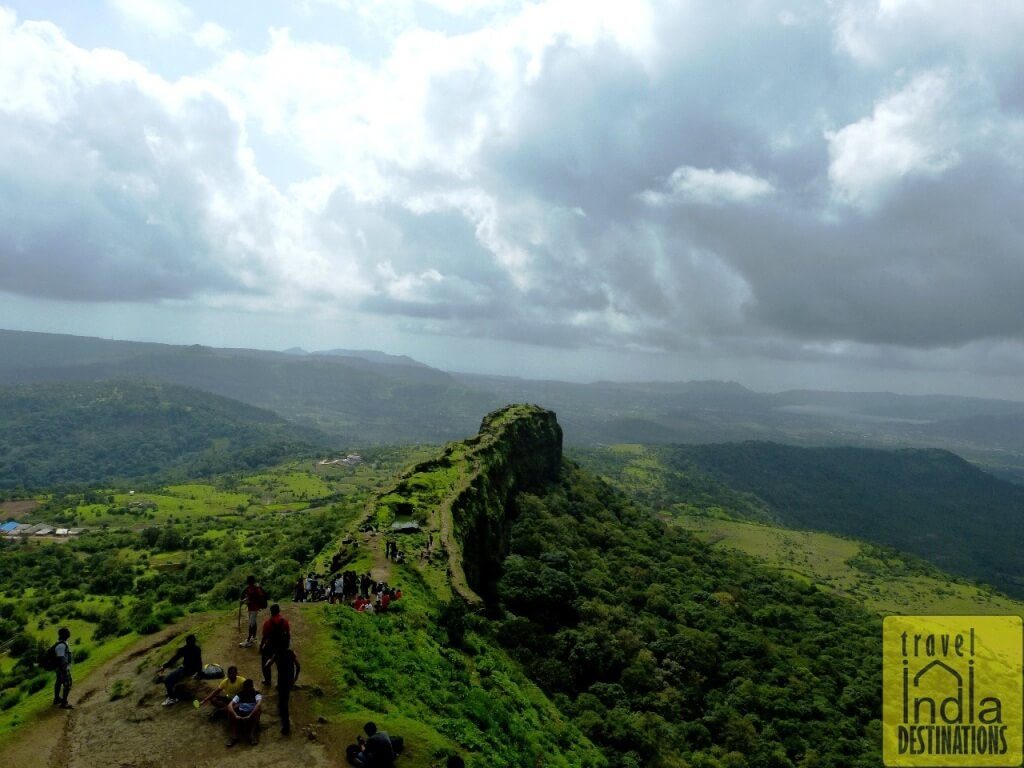
The Scorpion Tail at Lohagad Fort
While we were busy in our own world, admiring the natural landscape and clicking pictures, someone was spying on us quietly, probably waiting for us to leave, so that he can inspect if there are any food droppings.
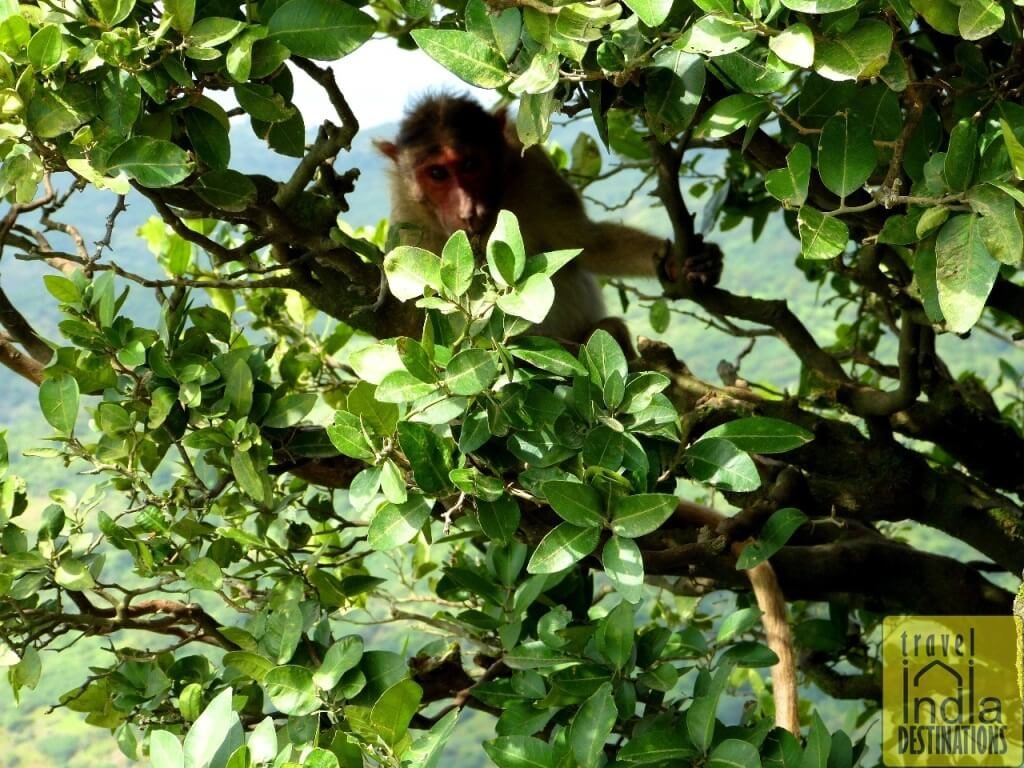
Someone’s Spying on Us
At the end of our Lohagad Fort trek, we came down the same path as we went up. We took a halt at these shacks that offered us the refreshments we wanted. They also provide lunch, breakfast and dinner, which you can choose from the menu.
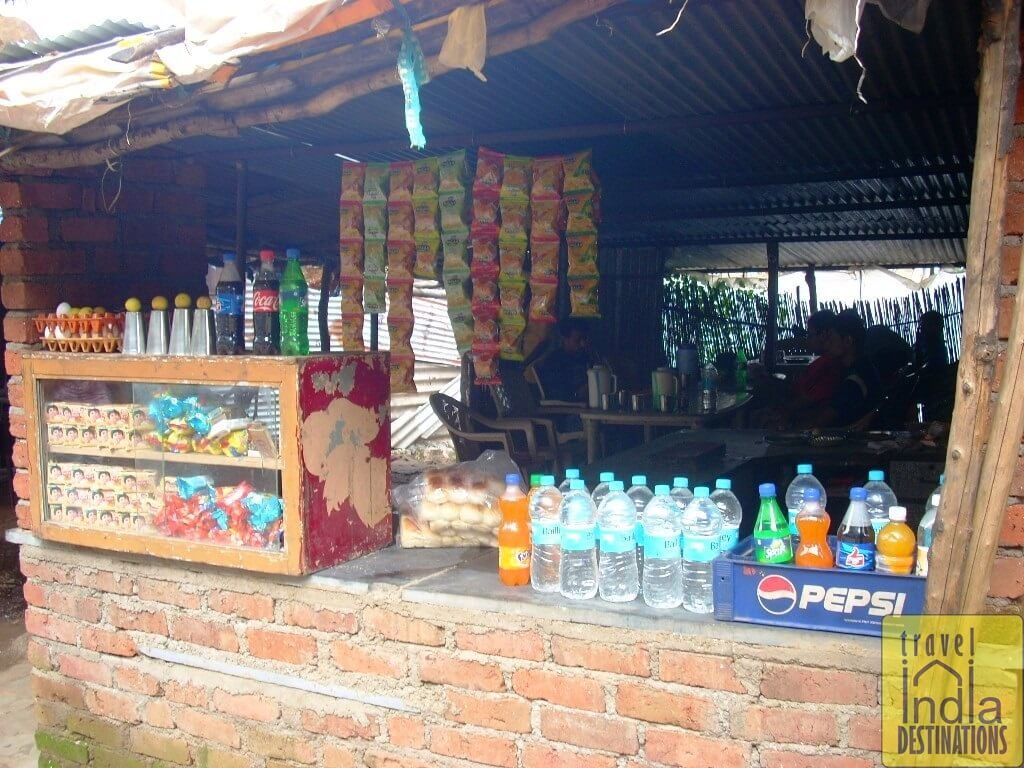
A Makeshift Shack
In the picture below, you can see the ramparts of the fort on the left side above the trees from where I shot the settlement area below. Here below is a house that also doubles up as a restaurant offering food to the hikers and trekkers on the Lohagad Fort trek.
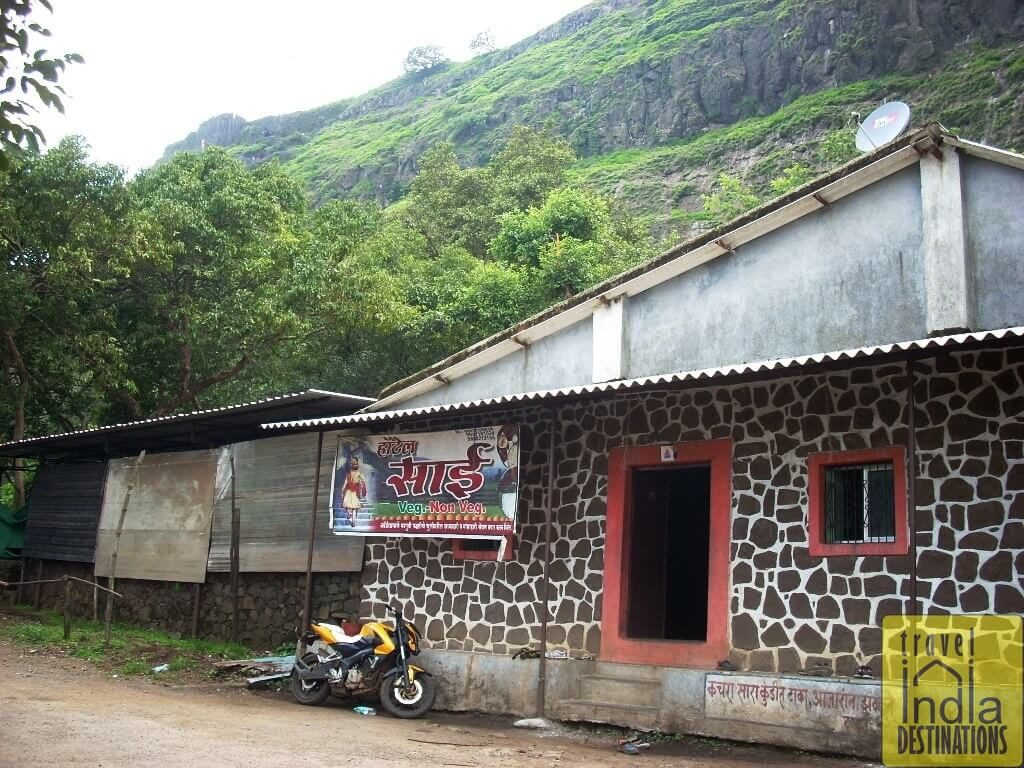
Hotel Sai at Lohagad Fort Base
The above picture is the home of the hotel owner. The picture below is the section where you can see they have a small store on the left. The patio area (below) which is the restaurant where hikers can chill out.
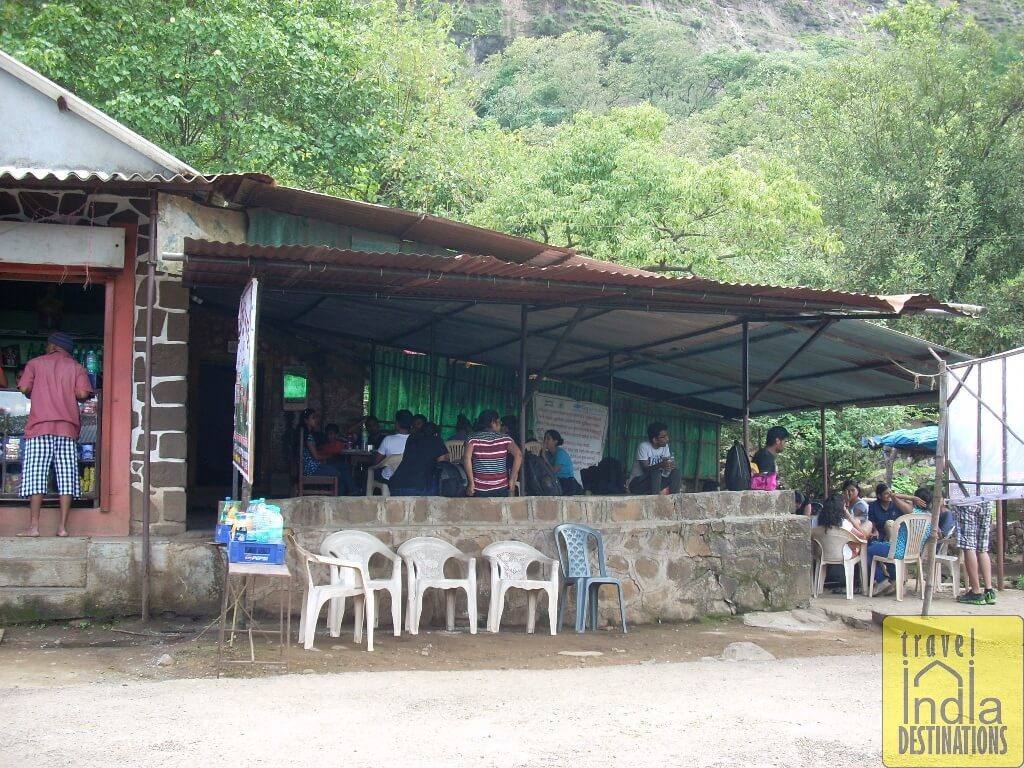
Tourists Having Refreshments After Hike
After our refreshments, we decided to hire an SUV and head to Lonavala from where we would catch our train back to Mumbai.
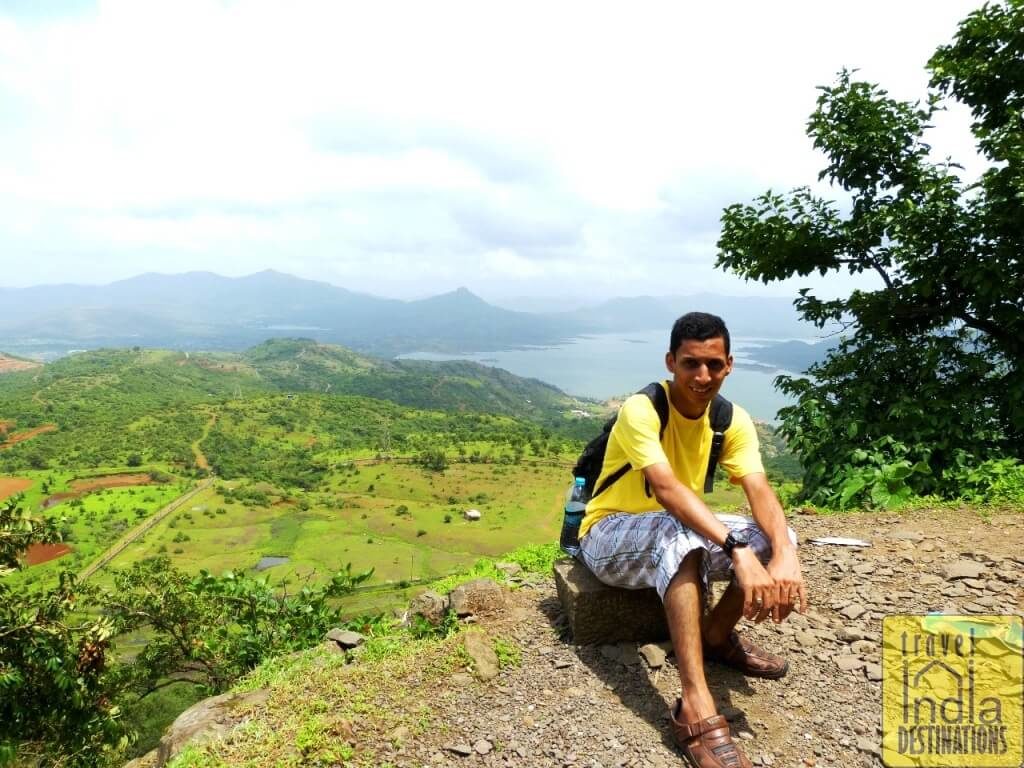
A Postcard Picture of Mine
Hope you enjoyed the three-part blog post of my recent hike to Bhaja Caves and Lohagad Fort trek. If you have already visited Lohagad Fort, please share your experience below.
If not, do let me know how you liked the post and probably some stories of the hike that you did in your country or town. I am always eager to listen to stories from all over the world.
13 comments
Thank you for taking us (and your camera) along on this hike. The pictures are beautiful and the description leaves me feeling like I was by your side. Such a beautiful area.
Glad that you felt that way. Mission accomplished.
Simply magnificent Sharukh. This is my very favorite posting of yours to date. I was with you in spirit I know., with the little dragonfly.😉 You all look so beautiful yhere at the summit and what rich cultural history yo be able to share. Of course no battles or wars are full of happiness but still to stand where ancestors stood always brings me a sense of oneness with everything. The landscape is so incredibel. Sarah and you have beautiful, happy smiles there. And now I am lonely for the mountains. Sigh.
Thank you so much for this post. I loved it all!
I’m glad that you felt the place in spirit. I wanted to share the history as well, although the fort was constantly changing hands.
You did a marvelous job. Just enough information really. Love the monkeys! I miss my squirrel monkey friends. Oh but in one of the photos of a wall, what is the writing inscribed on it?
You mean a picture which says Scriptures Carved on a stone?
Sharukh, always an amazing adventure to read your hiking posts. I’m with you every step of the way! Thanks you! Christine
Christine, I’m glad that you enjoyed it reading as much as I enjoyed it writing it down. Overall there are 400 images, these are handpicked ones.
Sounds as if a photo gallery is in order. Maybe a mosaic tile where they are all connected. I love to look at galleries like that. Christine
Will try and work on it.
Great! I’ve done mosaic tile photo galleries for many of my posts. The Welcome Page has lots of sunsets & sunrises from world-wide blogger friends. I just keep adding new ones to the mosaic tile gallery. Check it out for an example.
http://cerobinsonauthor.com
I clicked over from C. E. Robinson’s blog and had a look around. Too much to see in one look, but I viewed this entire post, and thought it was wonderful, especially since everything is quite unfamiliar to me there. When I have more time, I will browse through some more things. Great job!
Thank you for visiting my tiny India travel blog. I’ve tried my best to put up authentic information (not what media shows you on TV about India), so visit as and when you please.